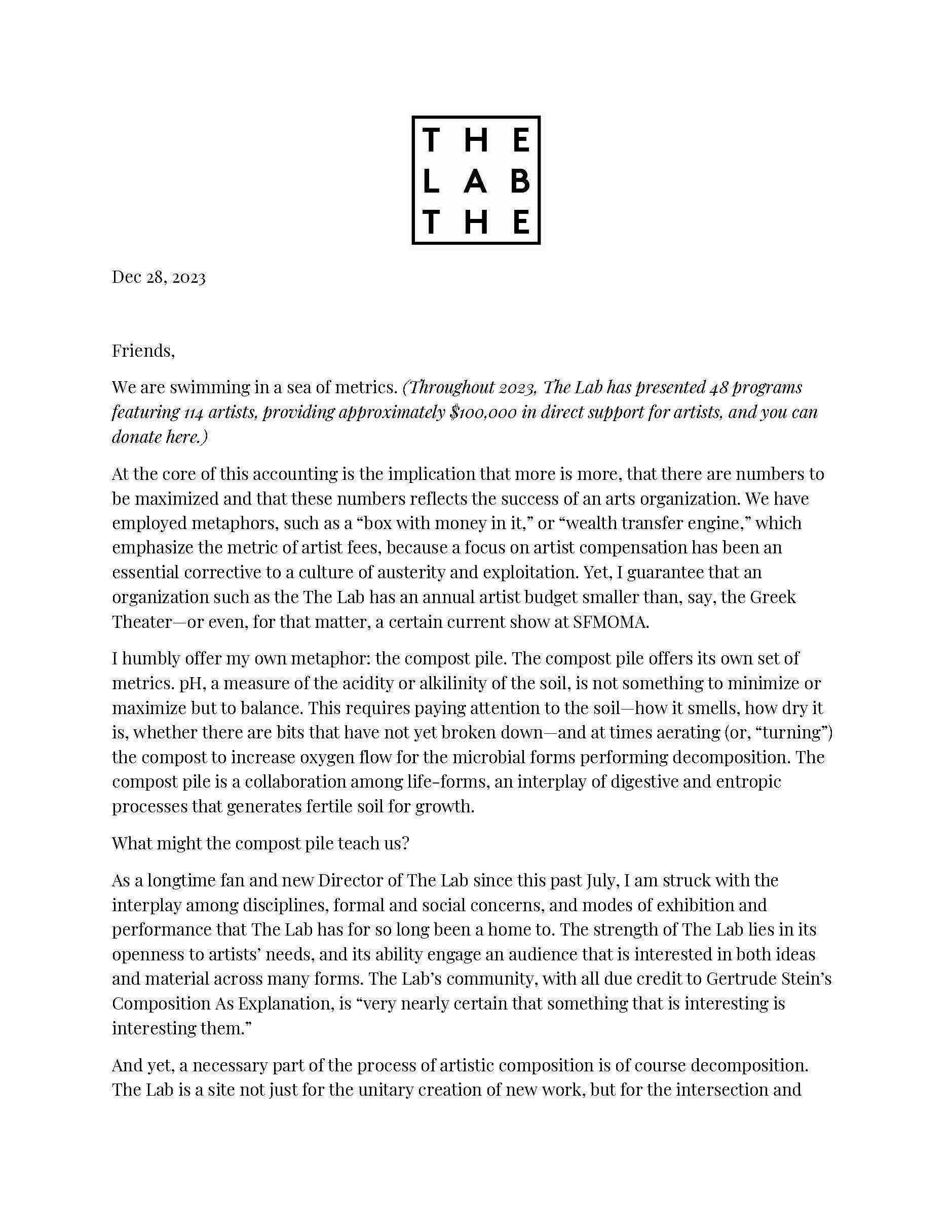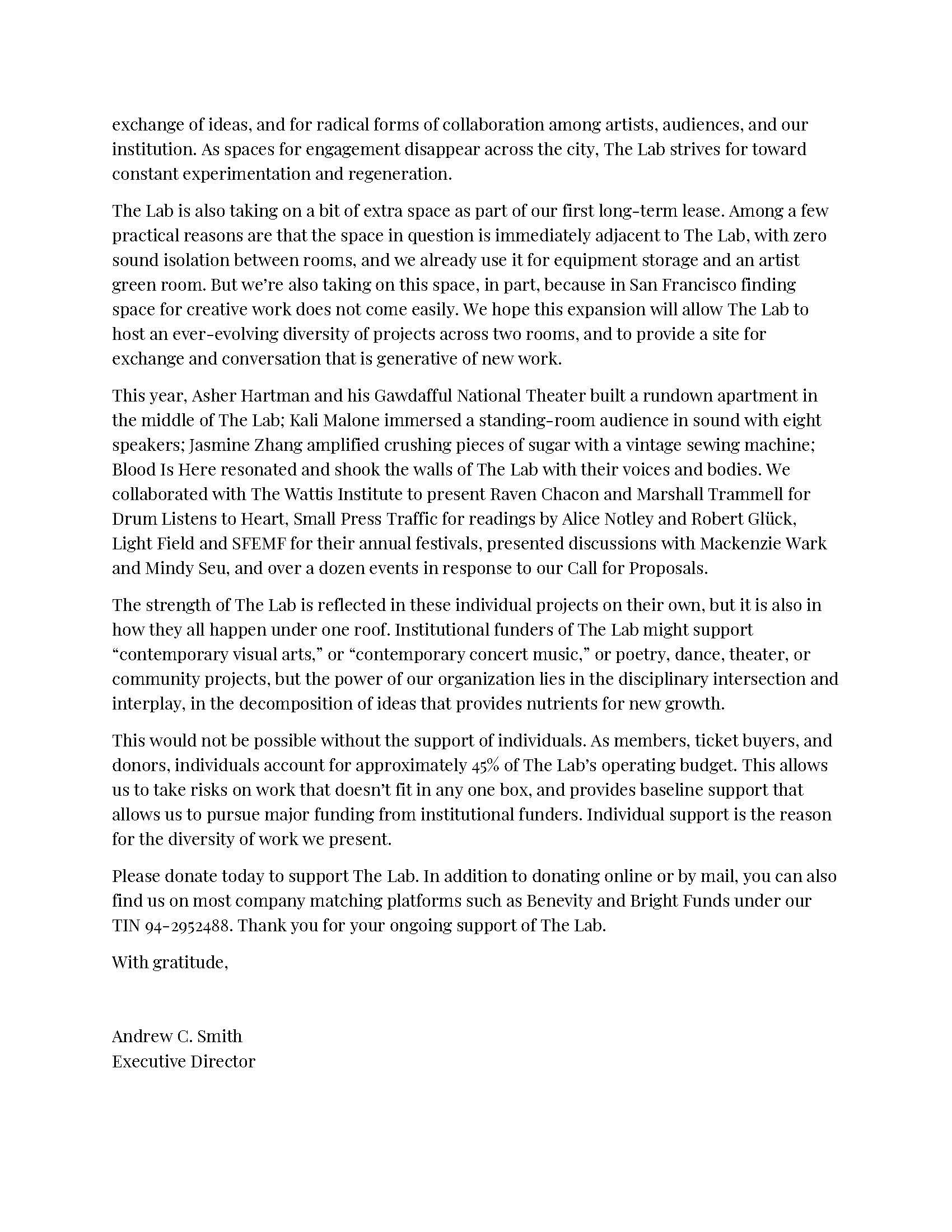The Lab Reports 2022
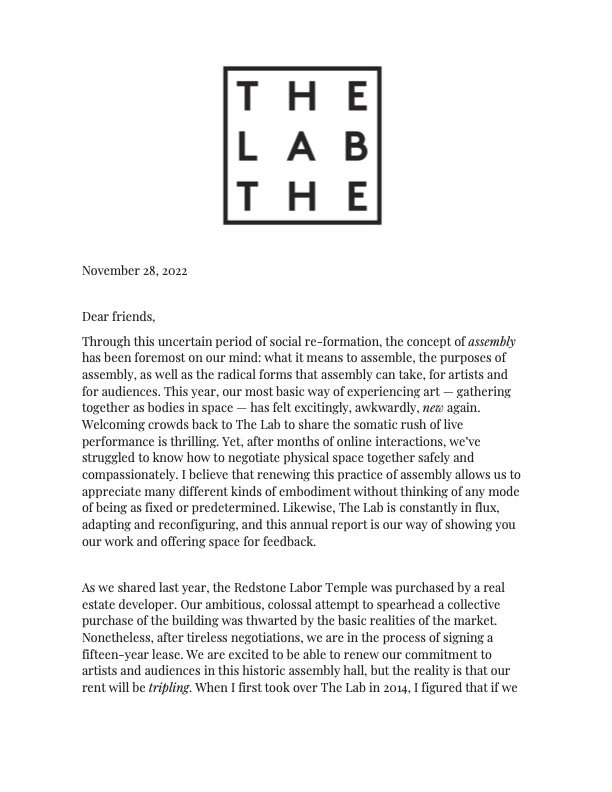

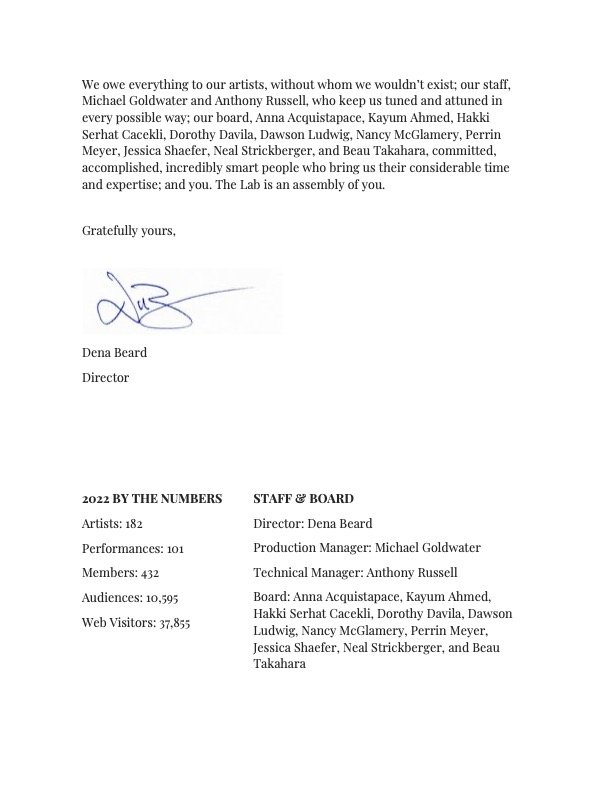

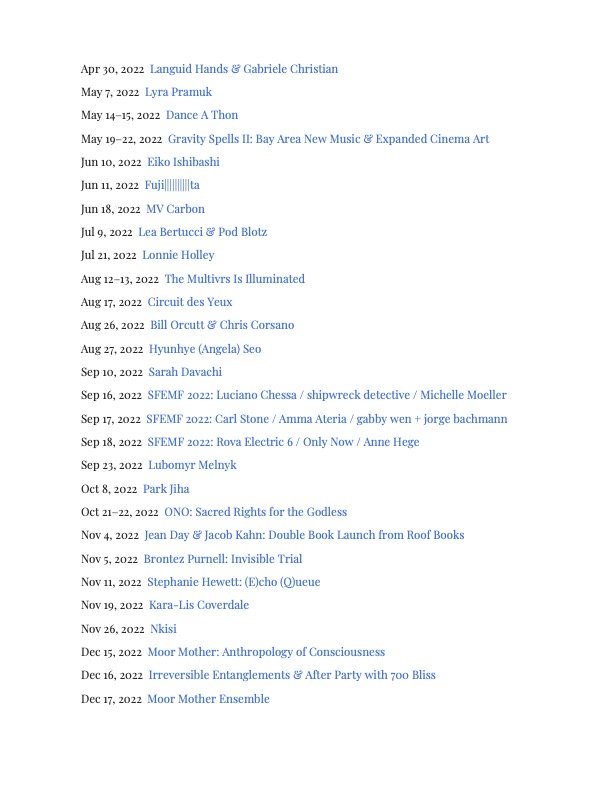
Exotic Muons in your Skin Respond to X-Ray Prayers During Trottelklown Krieg
Photos and text by Anthony A. Russell
A regular theme in Bonnie Banks' work is the imagining of things we can't see with the naked eye. As the elusive artist cannot be reached for comment, I can only discuss the contents of “Exotic Muons…” with the same speculative authority that you might apply to a precariously stacked mass of soggy furniture, home videos, and bundled ephemera abandoned on Capp Street by a forcibly evicted tenant that you never knew. How does one greet a large crustacean-primate wielding a ray gun loaded with cartoon paint spray? Teeth at the end of tubular protrusions may suggest mouths and throats, but you never really know what a beast can swallow without finding out the hard way, and not everything with wheels ought to roll. That is not to say that there aren’t tops and bottoms to some figures in Bonnie Banks’ inexhaustible cast of characters – I just don't trust anyone who would claim to be able to make heads or tails of it. That being said, I’ve studied everything in the show pretty closely, and despite the myriad of limbs, growths, and appendages twisted together in monstrous chaos, I can say with reasonable confidence that there isn’t a single “tail” in the whole exhibition.
Entering The Lab, one is met by a sight that ought to be familiar to anyone who has ever attended the Brutal Sound Effects Festival. Screwed directly into the steps are prop picket-signs in the shape of houses from a play about gentrification by some completely unrelated theater company. They seem to have fallen into Banks’ possession before being transformed into an assortment of painted figures that both greet and ward off attendees like heads on spikes. The house-shapes now function as arrows pointing upwards, beckoning-burbling-“show’s this way”... just in case you were wondering if you were in the right place. At the top of the stairs are a few banners crowded among other miscellaneous posters and xerox blowups of illustrations with motley splashes of reclaimed wash water from paint brushes.
Banners like this are how I first encountered the art of Bonnie Banks. Performers for Brutal Sound Effects Festival and its daywalker cousin, Godwaffle Noise Pancakes, will find themselves the recipients of custom signage made specifically for the event. Text strewn over assemblages of scrap materials, xerox scans and original drawings adorned with unspooled VHS and cassette tape like amber tinsel dress the set, pulling the diverse components of the stage into manic cohesion. Flyers before the show, signage during, and custom sleeves for DVDs after, all bear the distinctive and brutal hand of Bonnie Banks like a troubling green glow over a bubbling marsh of radioactive waste. This work is shared so freely and so copiously that it may be easy for some to overlook the frightening attention to detail.
I have wondered if it is at all appropriate to freeze them. All these things are meant to growl and quiver and flash and flop around.
Some forms were commissioned as slides or playing cards for role-playing video/board games. They serve to represent adversaries while also eerily connoting a fantastical terrain. When we see them in situ our focus is on the rolling dice.
On stage, it’s the performers, forming a kook-garbage train under the Bonnie Banks umbrella embracing other cast members on a detritus-ridden lake shore.
Paper puppets come to life as videos and stage visuals for collaborative projects such as The Organ Spectacular, Commode Minstrels in Bullface, Hans Grusel’s Krankenkabinet, Spider Compass Good Crime Band, and Rubber (() Cement.
Even backdrops can’t be compelled to sit still. Stage contraptions for another festival series, “Electronic Puppenhorten” as well as live acts Rubber (() Cement and Scummerai, bring together friends, machines, and audience members to activate frantic caricatures of hulking, jittering machinery resembling primitive, cybernetic sputterings of confused and feverish sentience.
It never stops. A thing is never just what it is. No reliable narrator ever chimes in to explain why the joints bend the wrong way, or which appendages are vestigial. Trying to play a DVD of the Rubber (() Cement Butyl RNA World movie is like being swallowed into a mutated maze of an intestinal tract composed of animated menus and ambiguous buttons that sometimes lead to a strobing abstraction of a live performance where a mass of debris and anatomy from across the zoological spectrum springs flailing to life in an onslaught of noise and madness flung into the audience like so many rogue electrons.
So I have wondered if it makes sense to freeze these things. But even when paused, I feel that I can look at these costumes and puppets and illustrations and see them squirming- and ultimately I am grateful to have the opportunity to spend more time with the mud golems. While I’ve seen the live act several times, I never knew until now how many faces this thing had.
The Lab Reports 2021
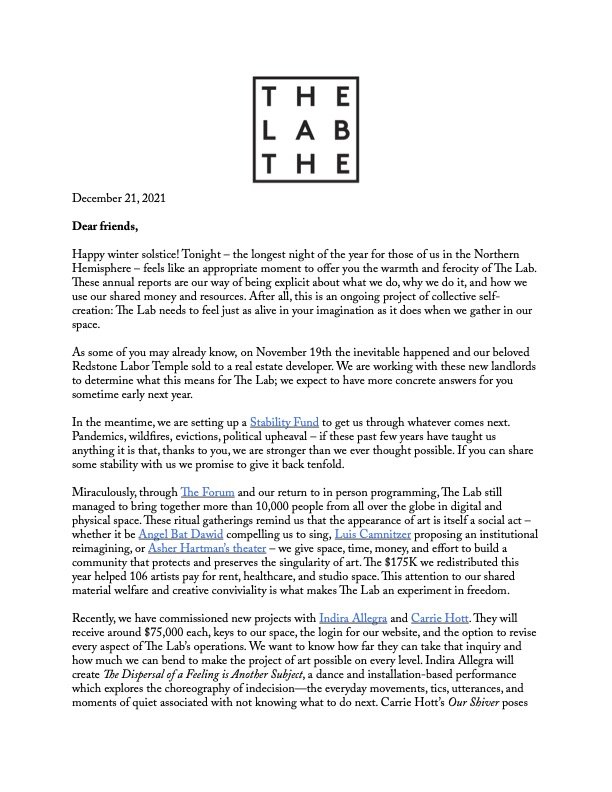
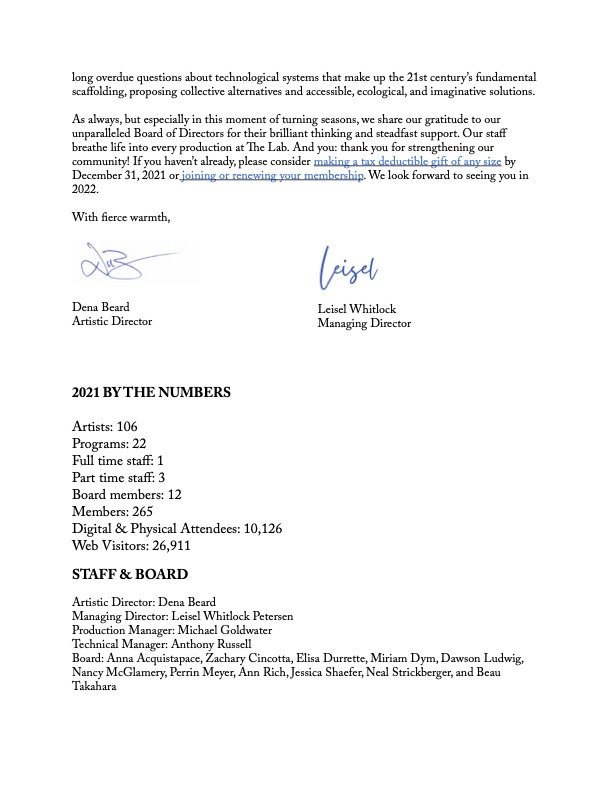
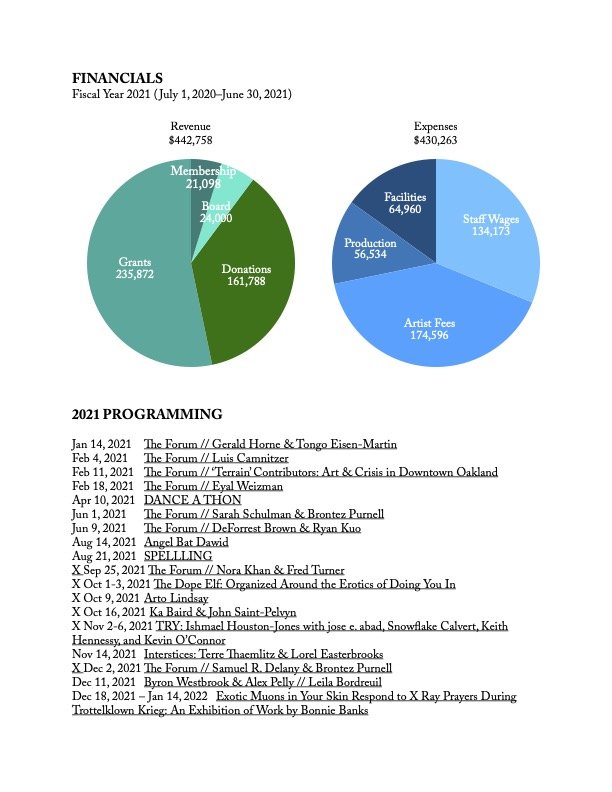
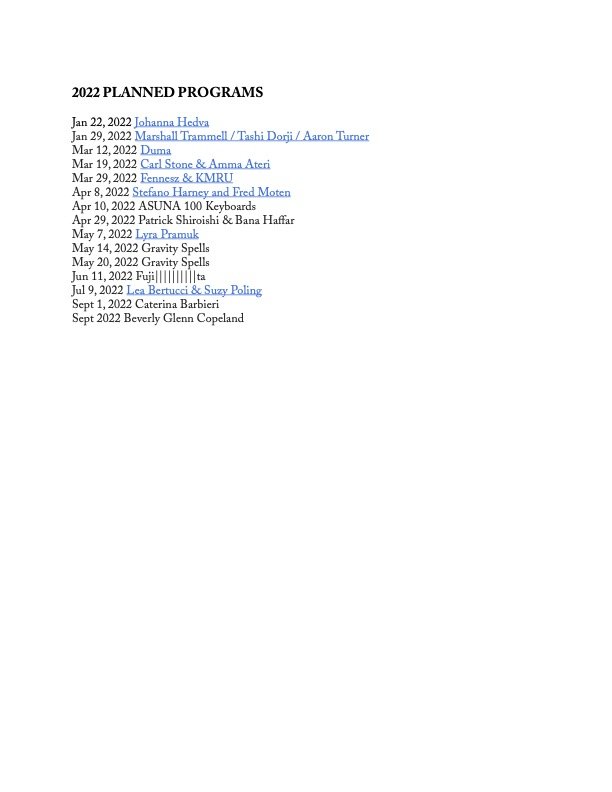
The Lab Reports 2020
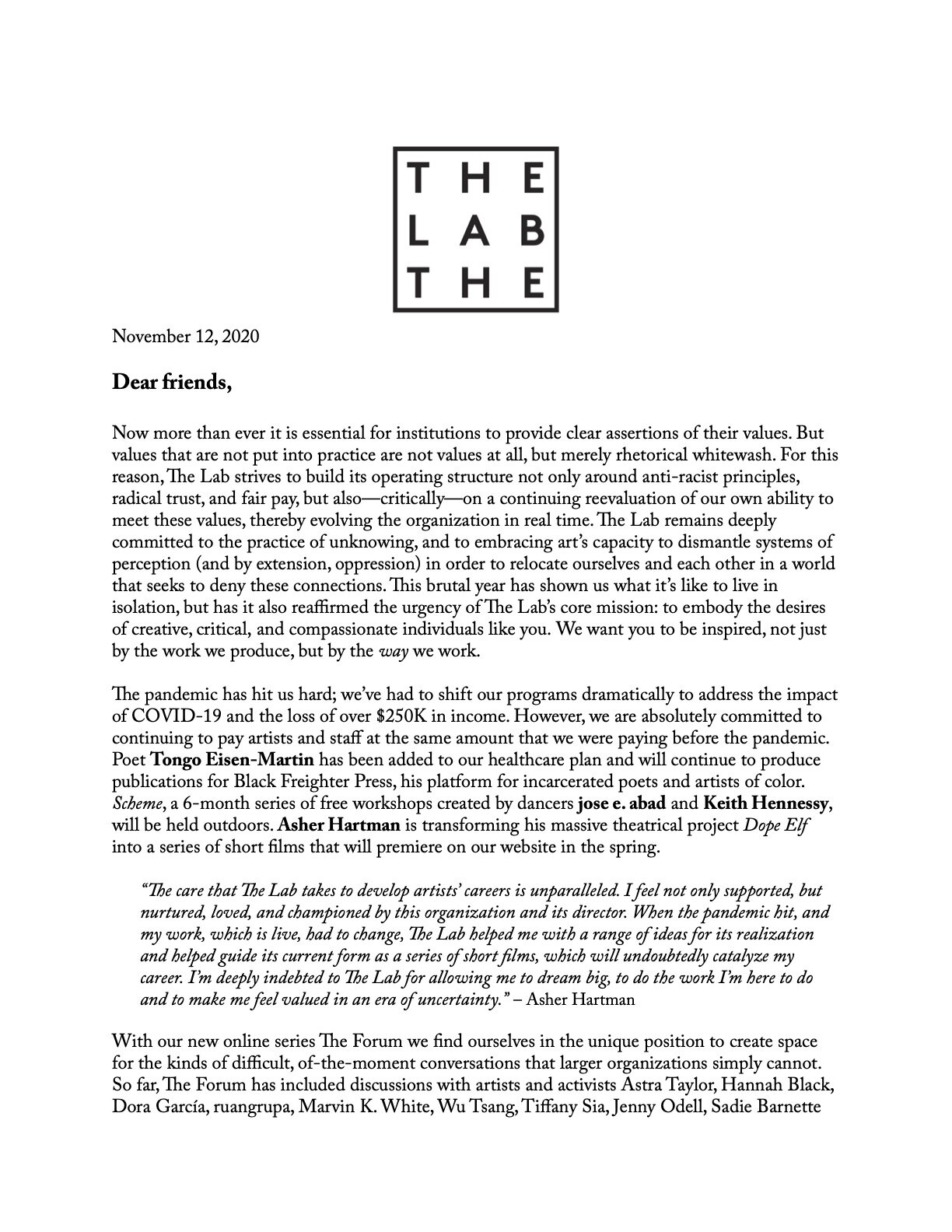
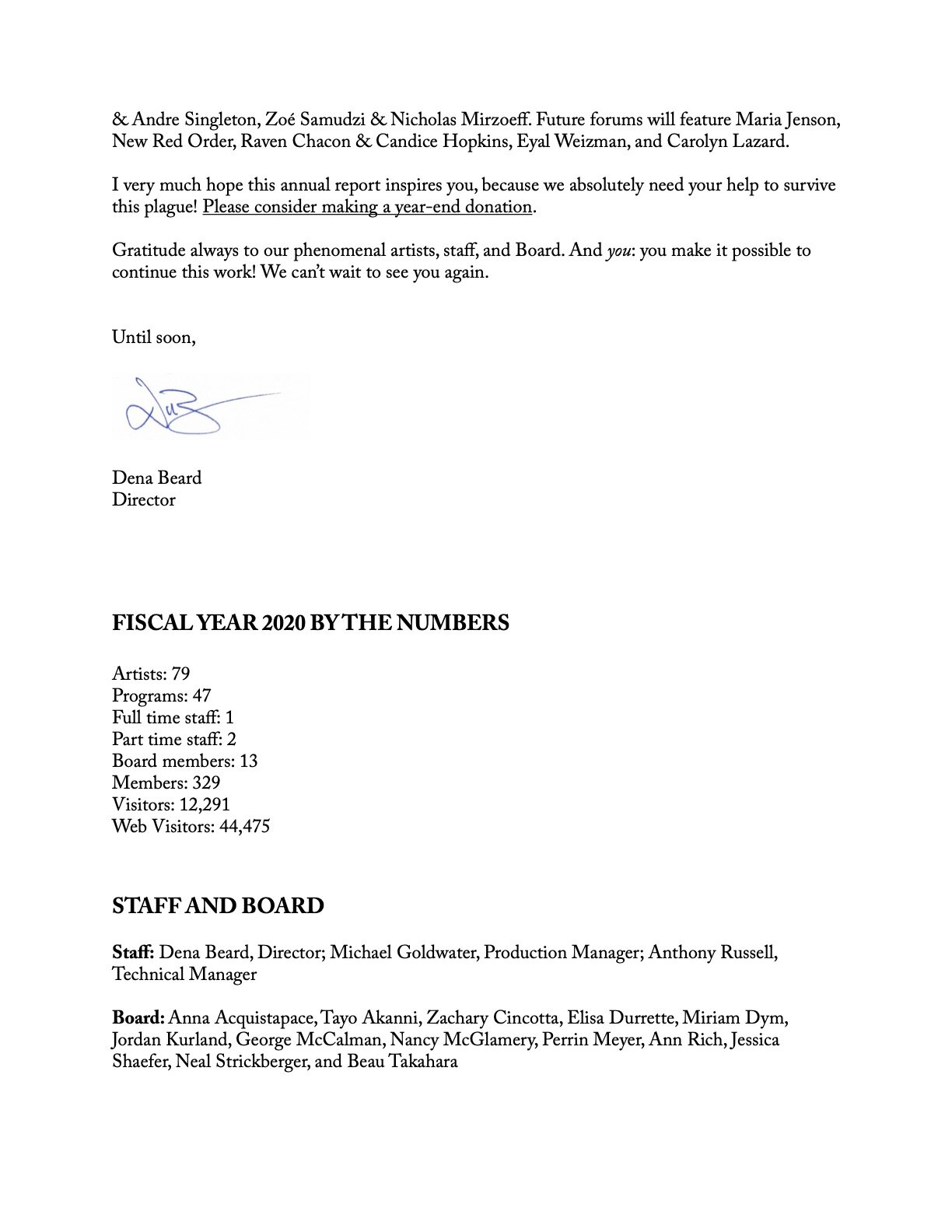
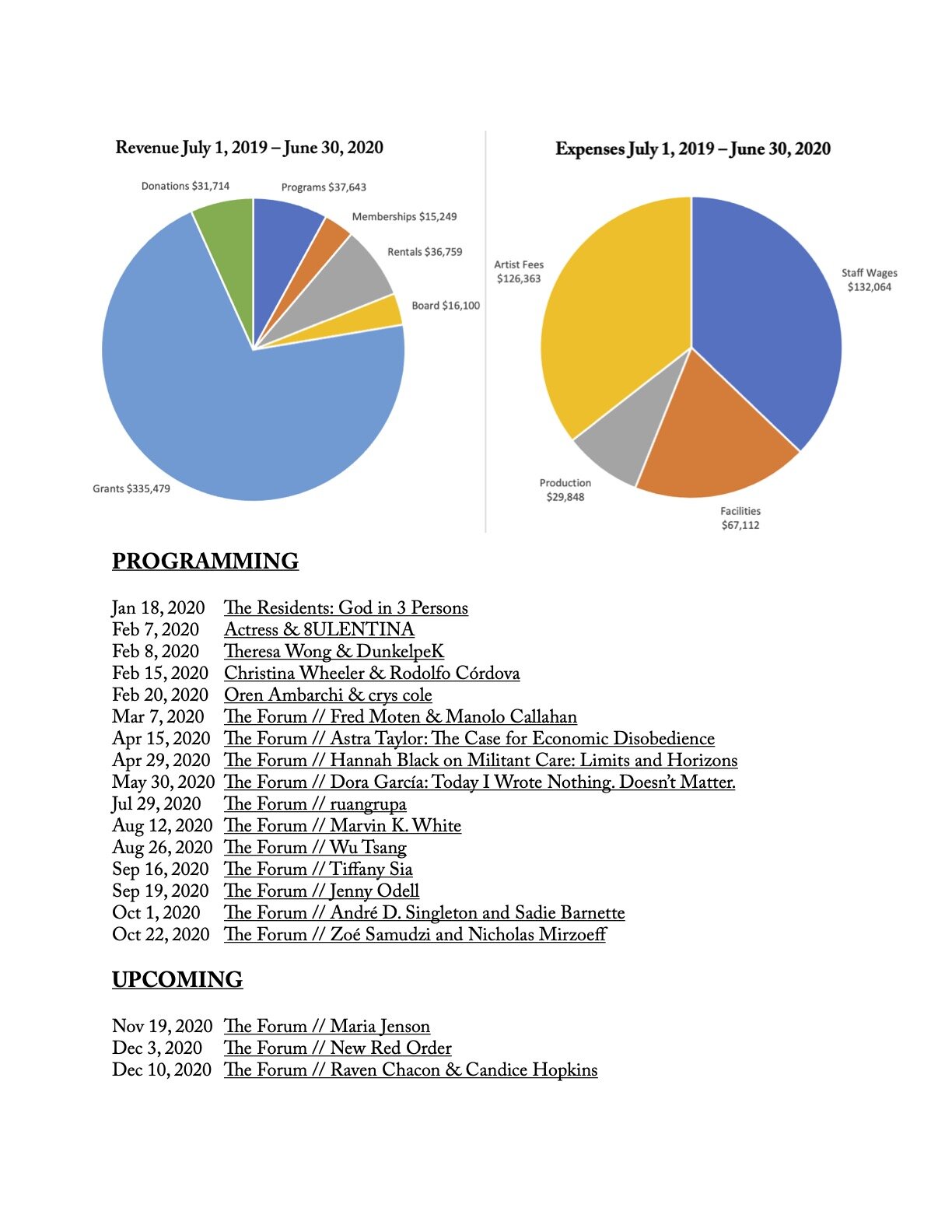
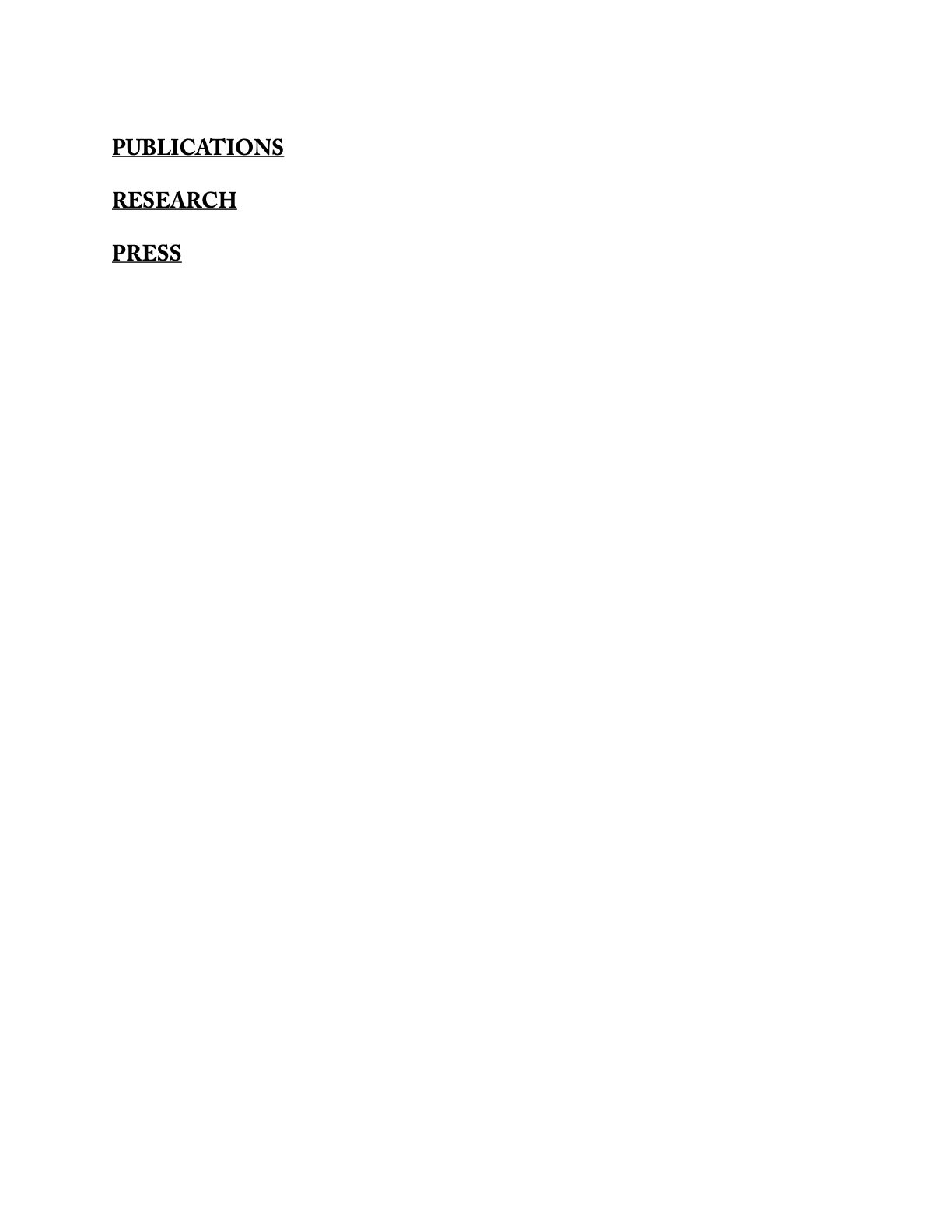
The Lab Reports 2019
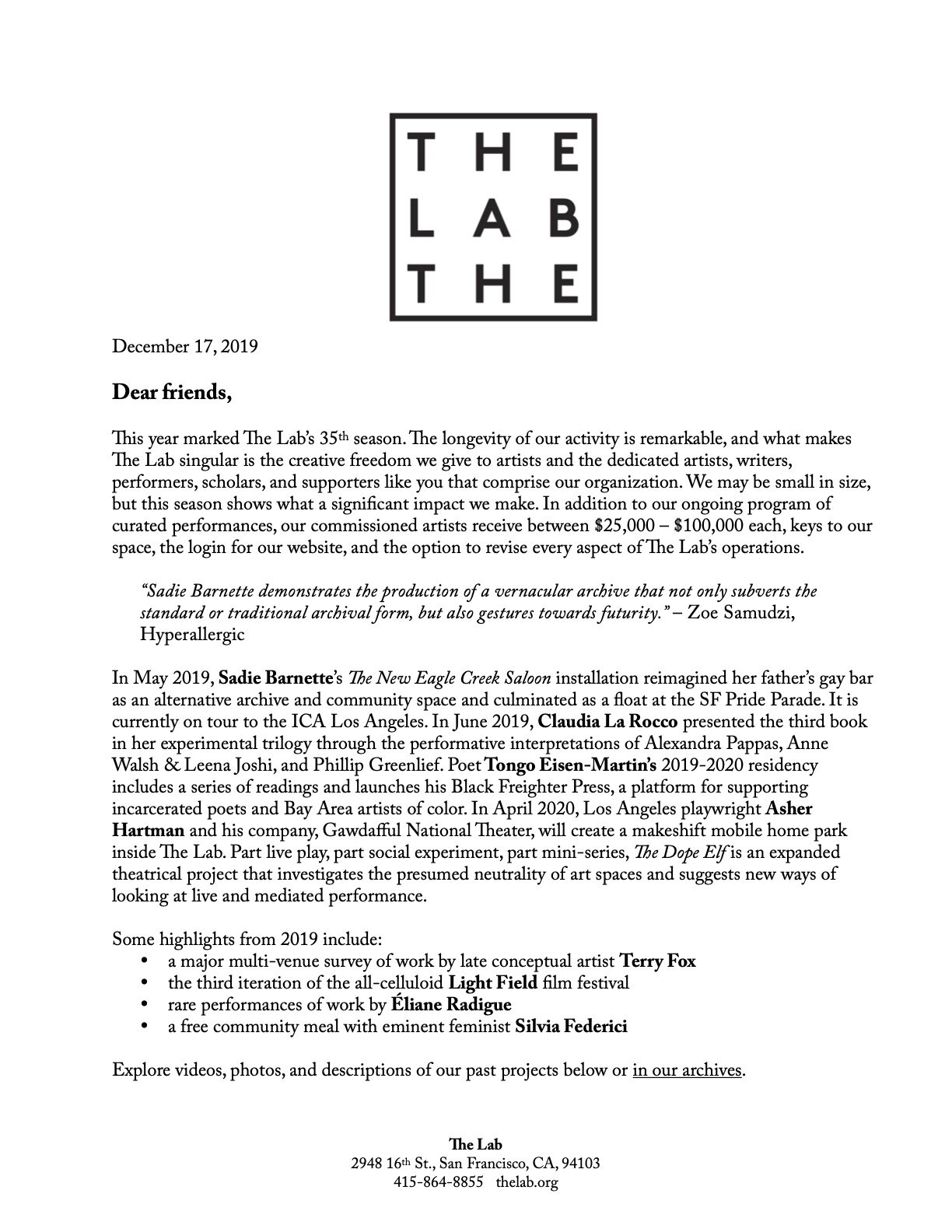

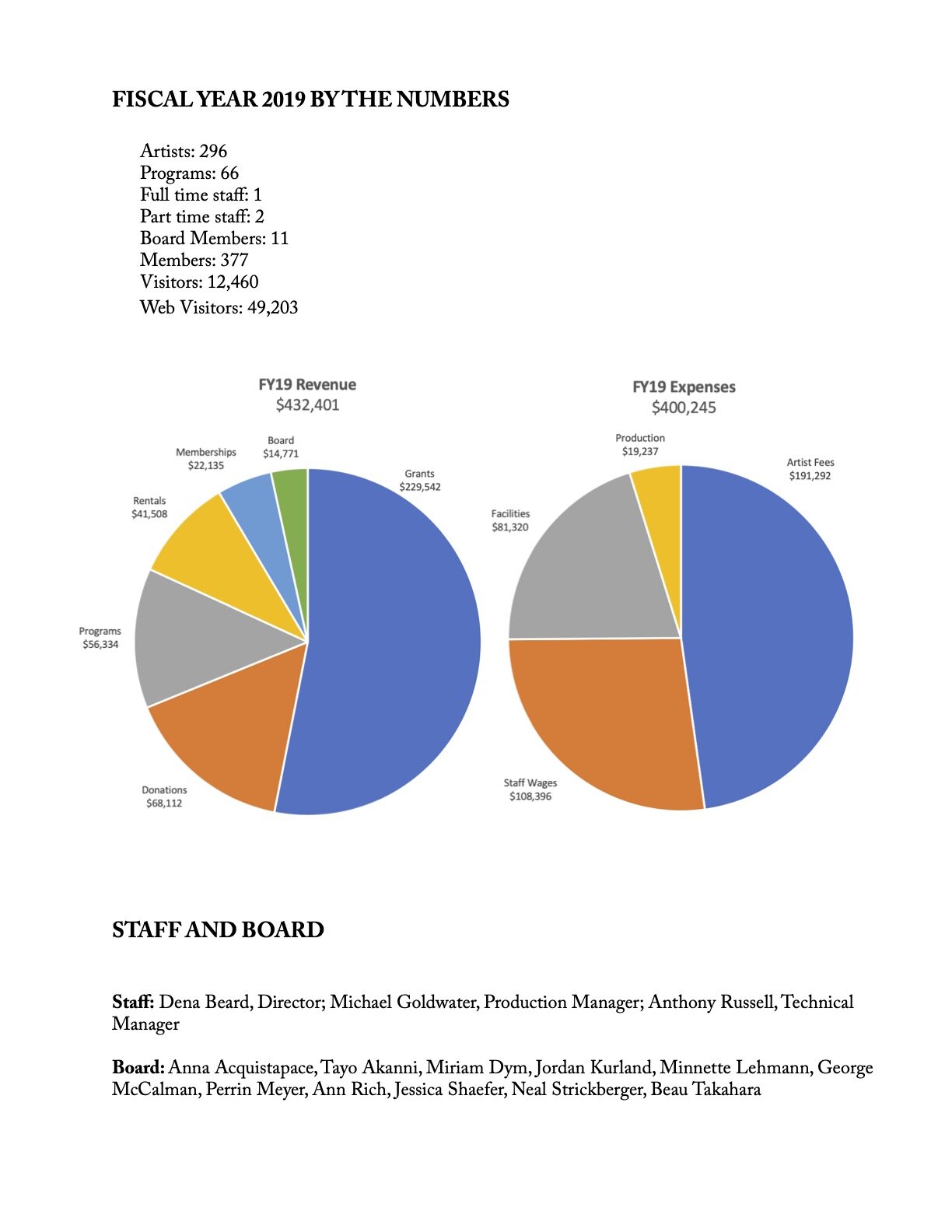
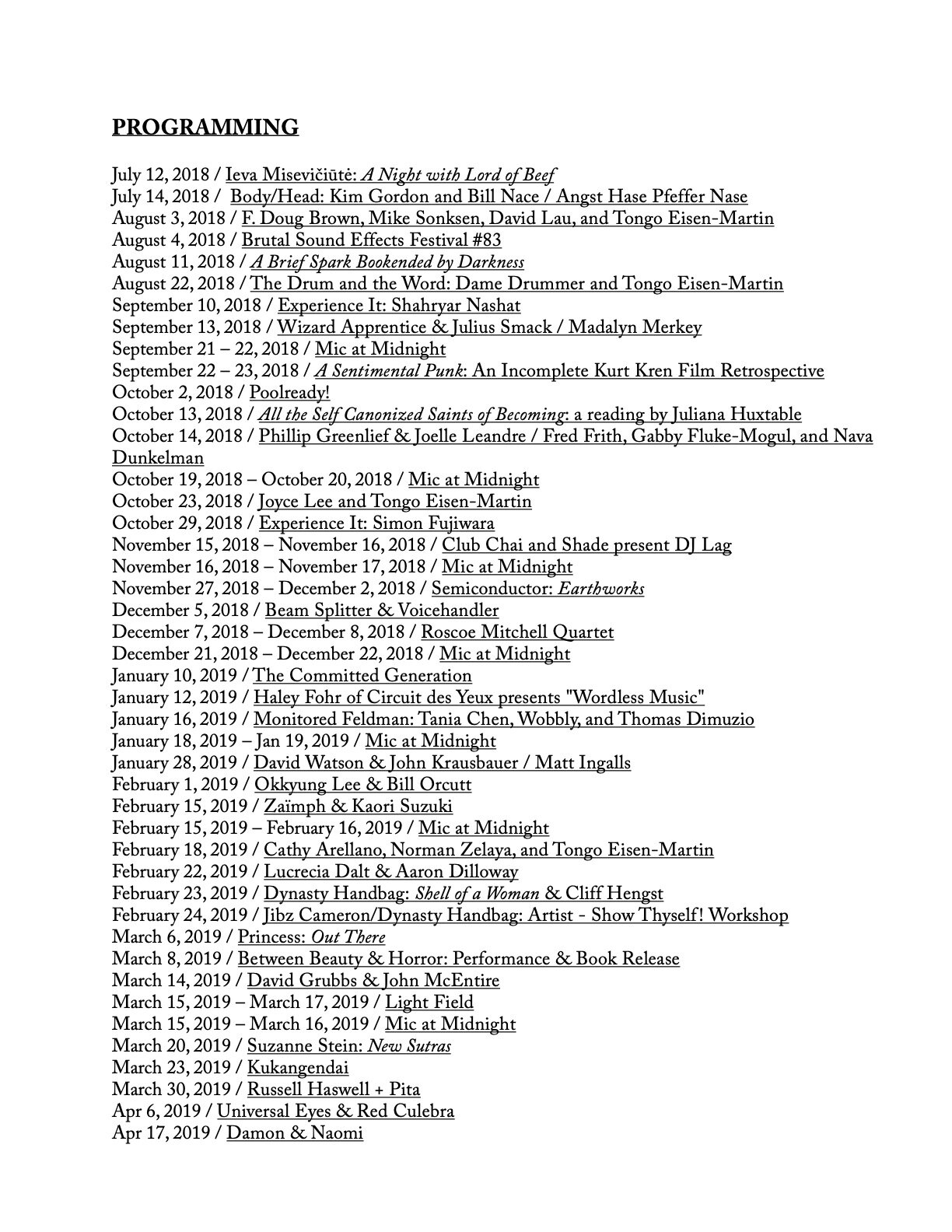
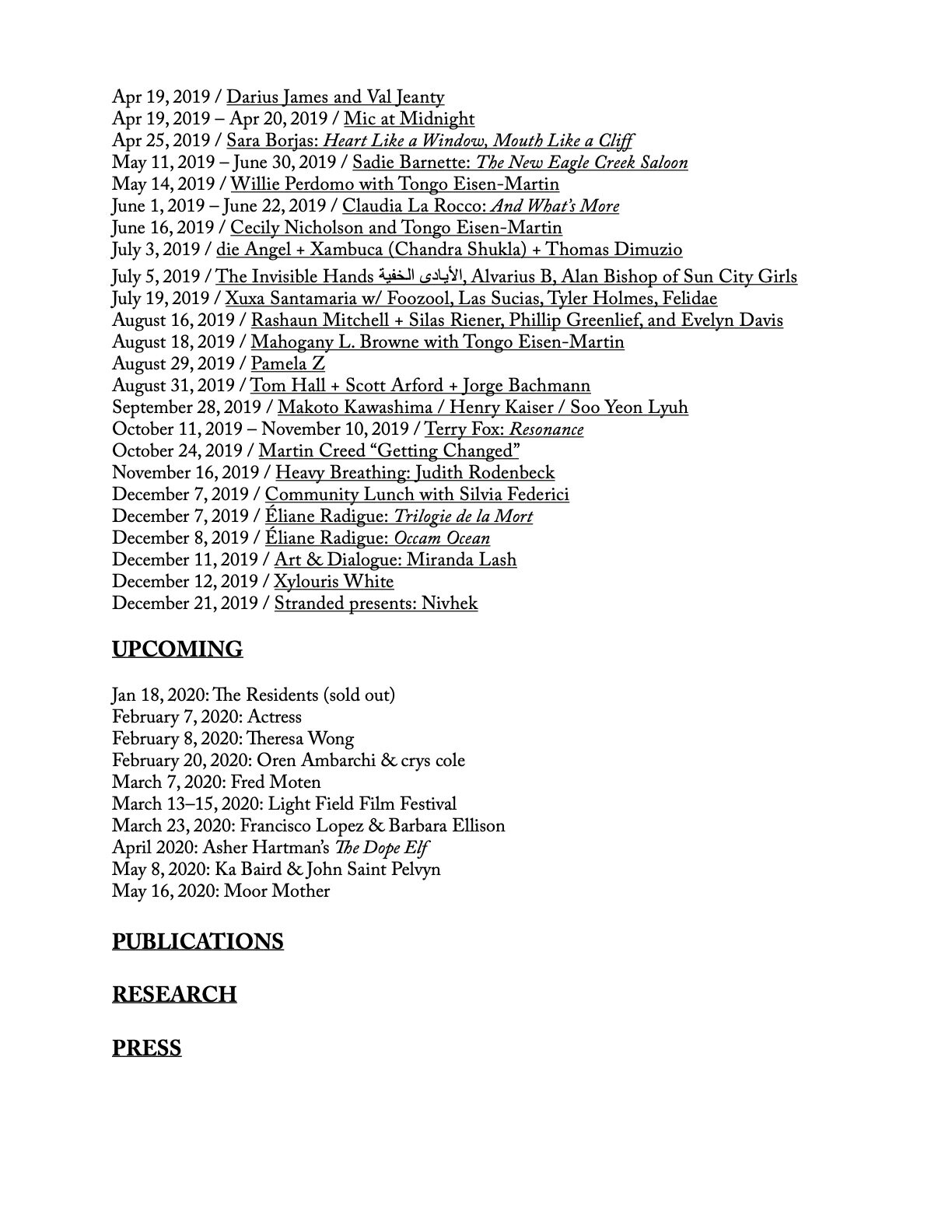
History of the Redstone Labor Temple
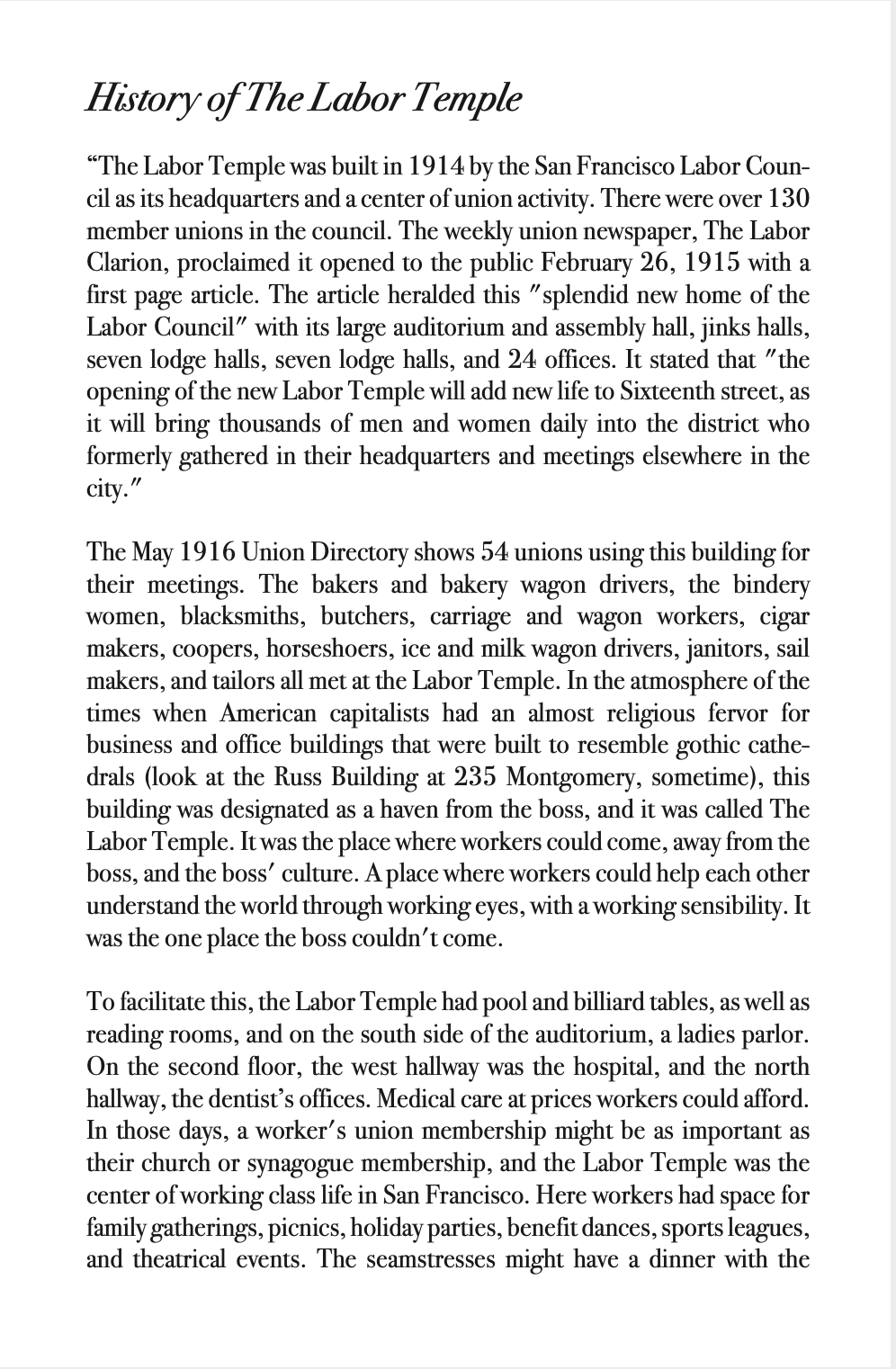
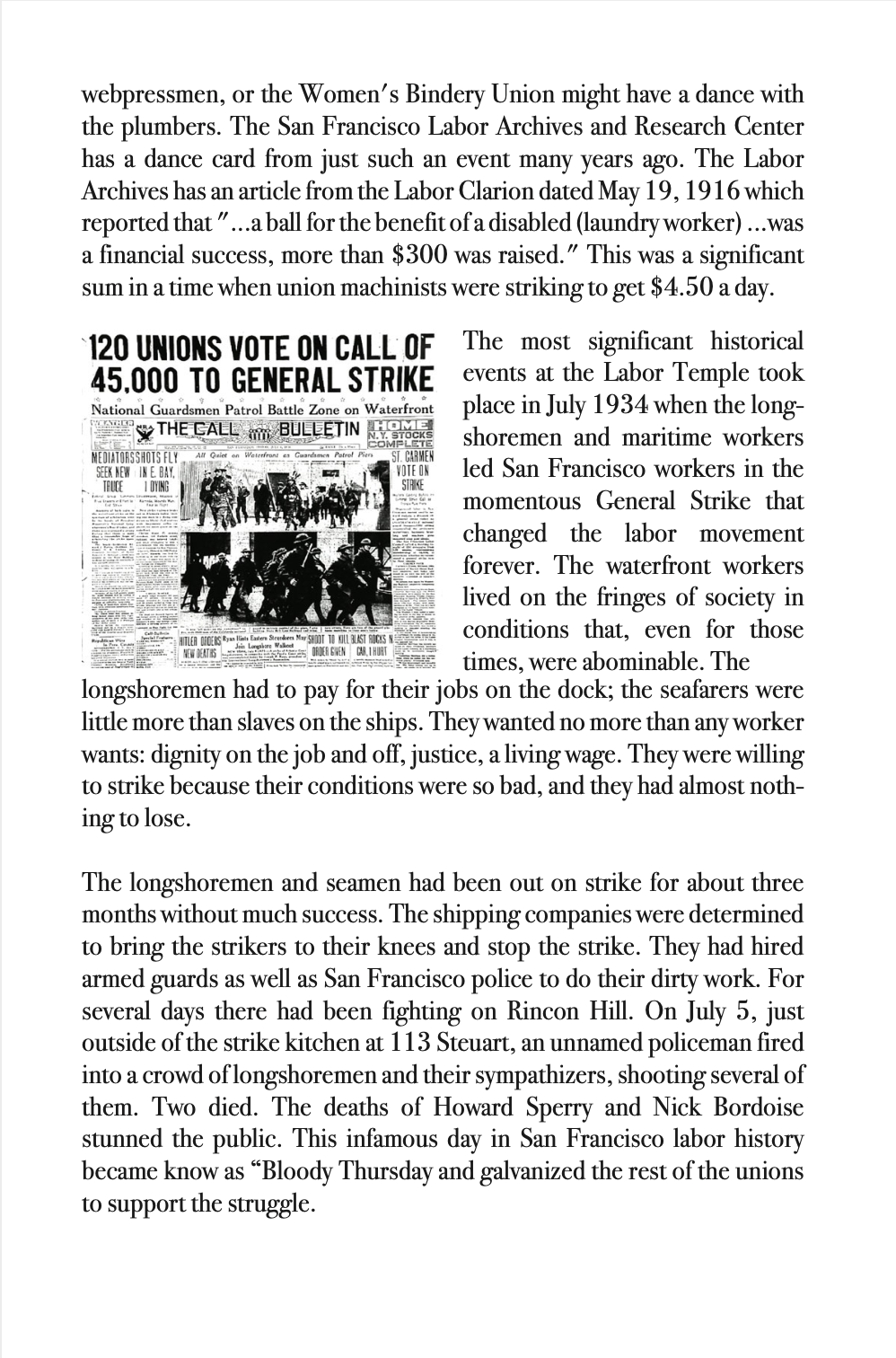
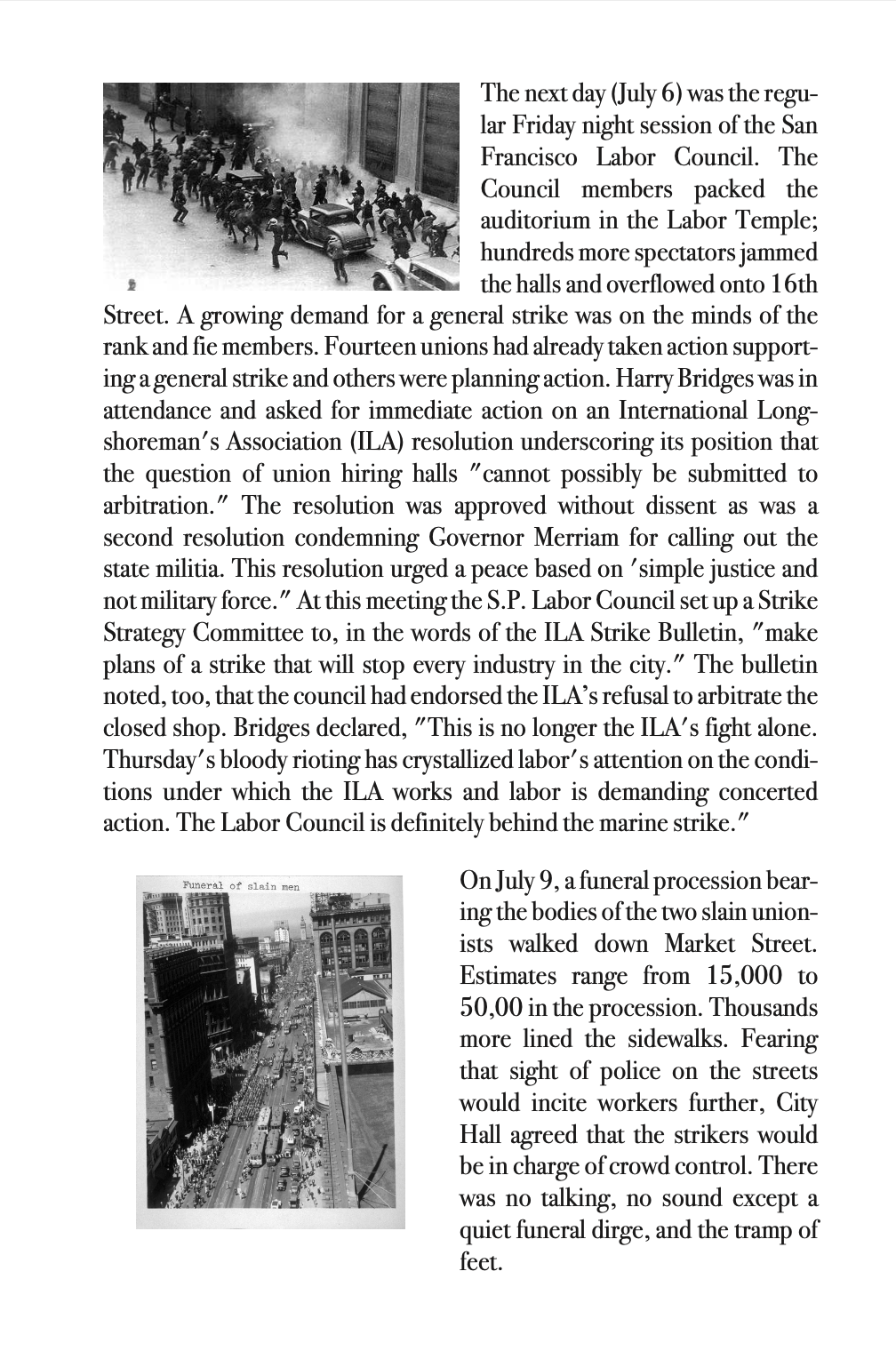
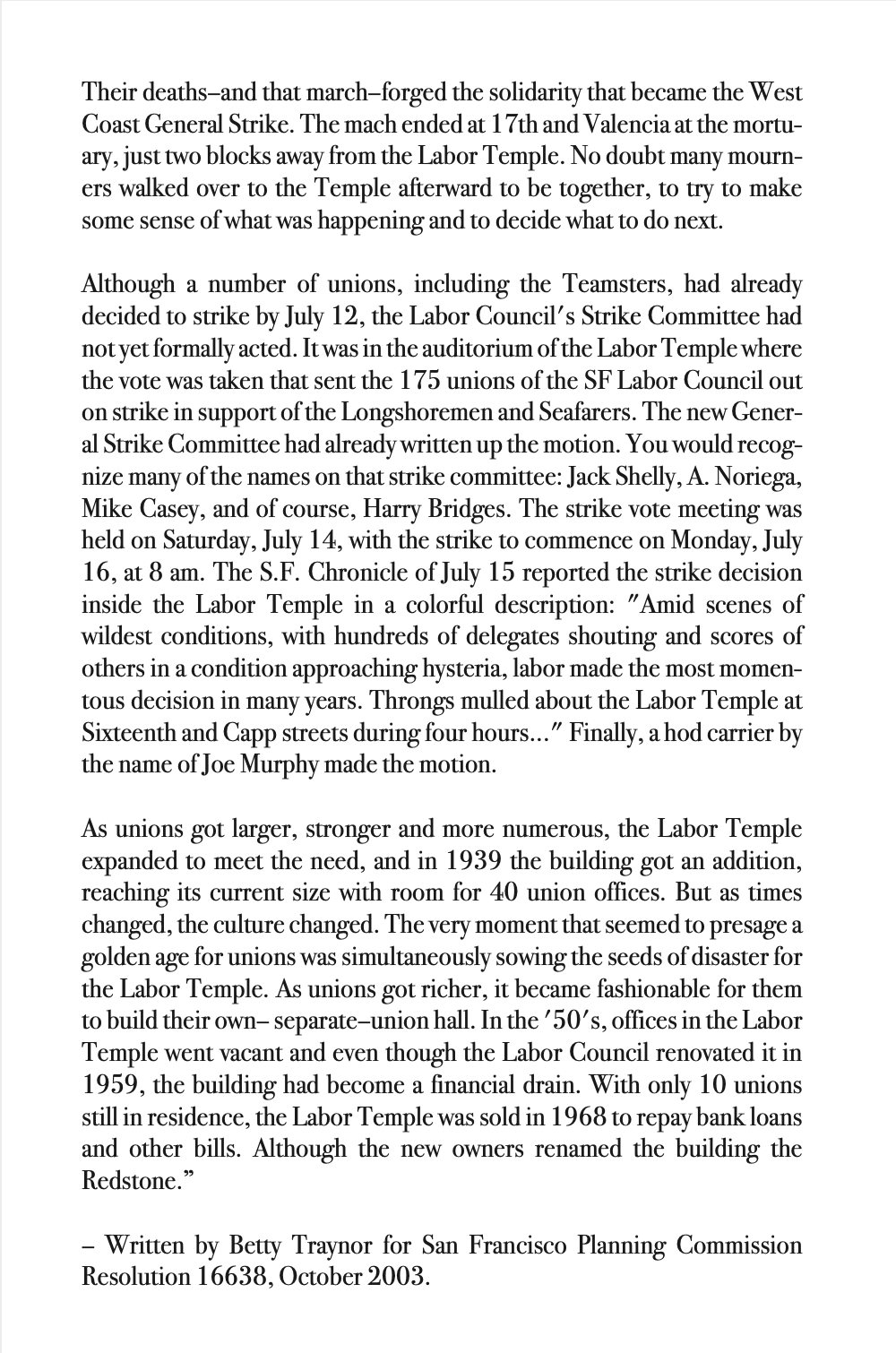
Resources for the Bay Area
Bay Area Common Wealth
Together with designer & doula Yula Paluy and over 100 contributors, we assembled the Bay Area Common Wealth guide to increase the visibility of and access to existing cooperatively-owned resources and alternative networks available to our community. Download and share the printable PDF and help us continue to update this guide throughout the year: https://goo.gl/dRqPZU.
Negotiating Fair Pay in the Arts
How do we create a better art ecosystem? Art consultant Beth Pickens responds with an essay on why equity and fair compensation go hand in hand. Artist Carrie Hott maps out the annual budgets of Bay Area art institutions. Use her map alongside our guide to WAGENCY to start negotiating for fair compensation for artists and art workers.
The Lab Reports 2018

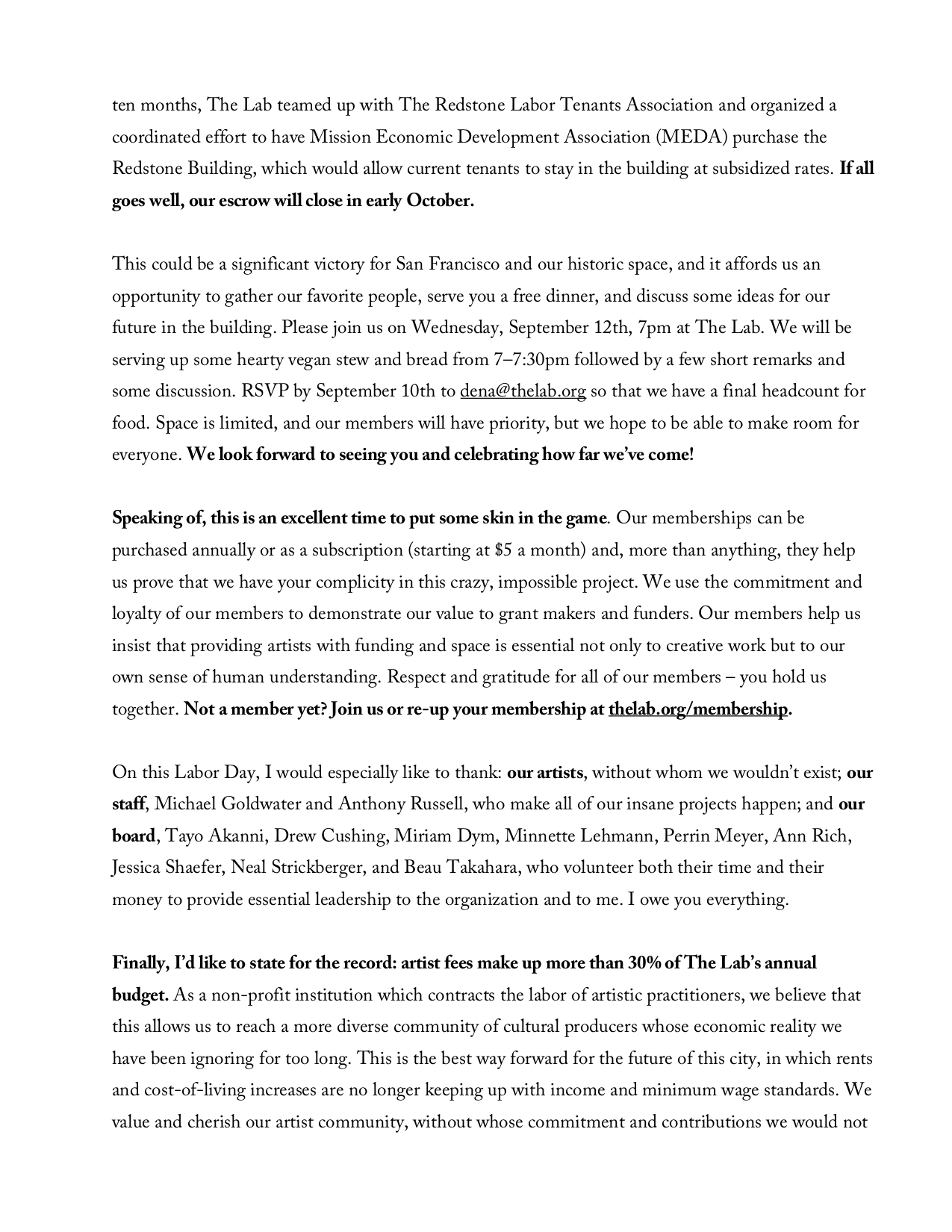
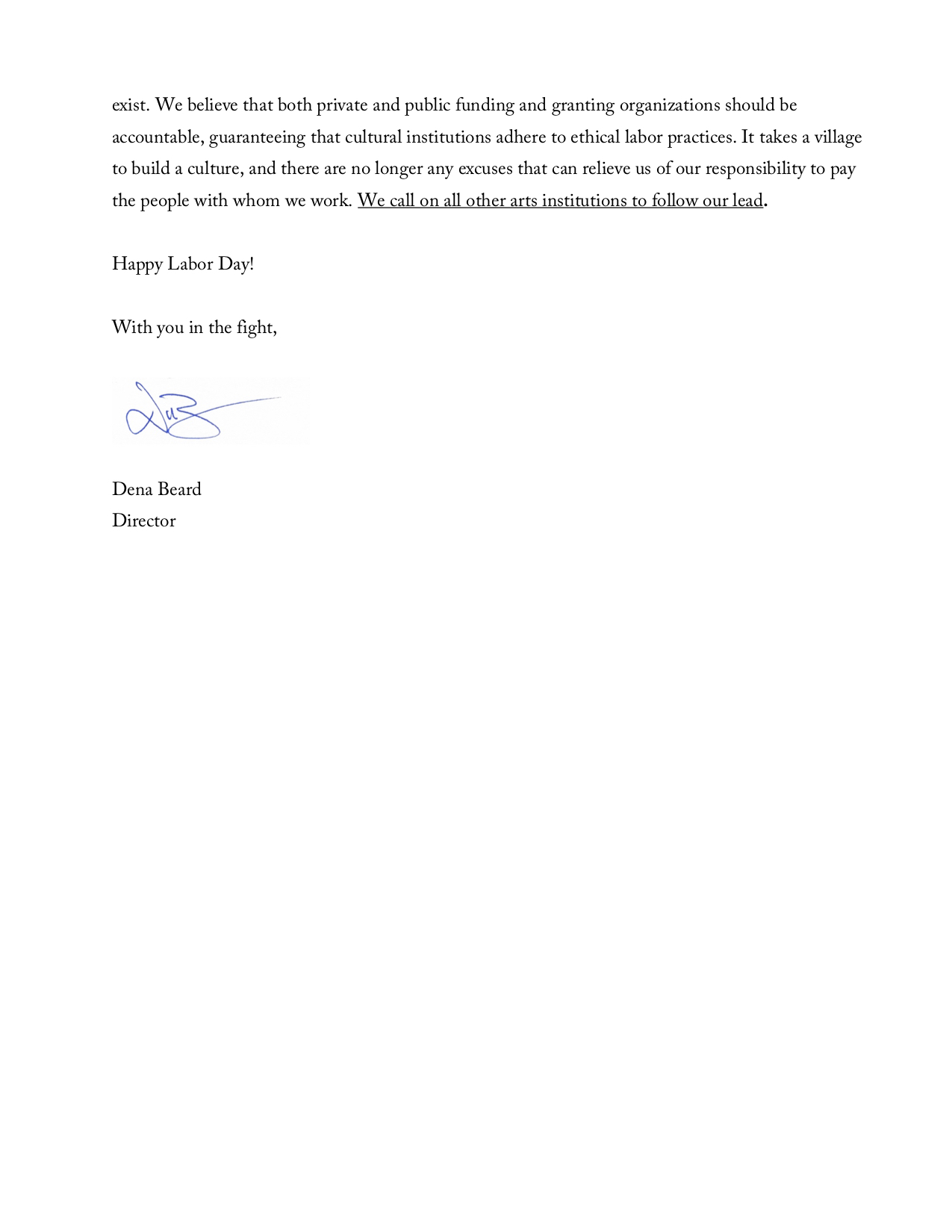

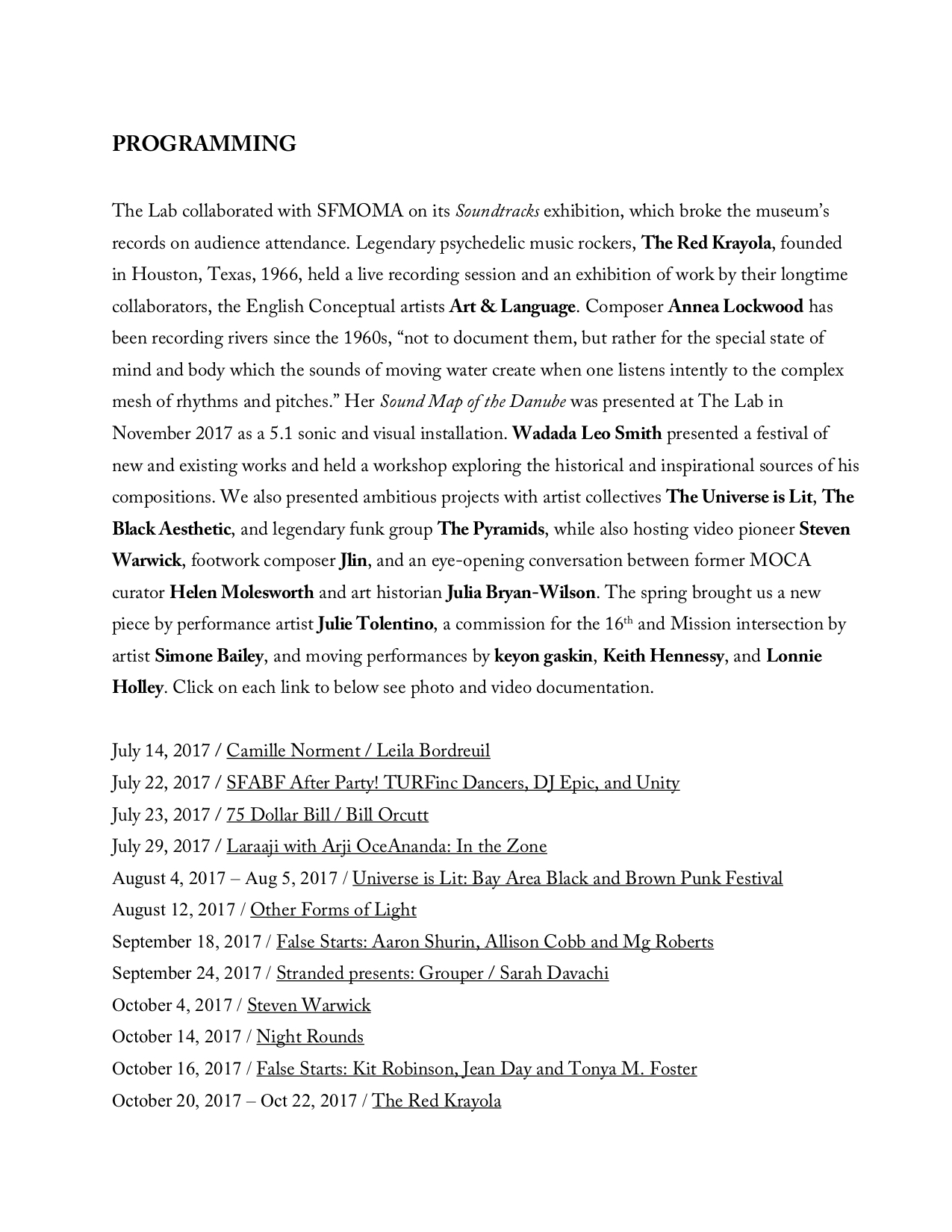
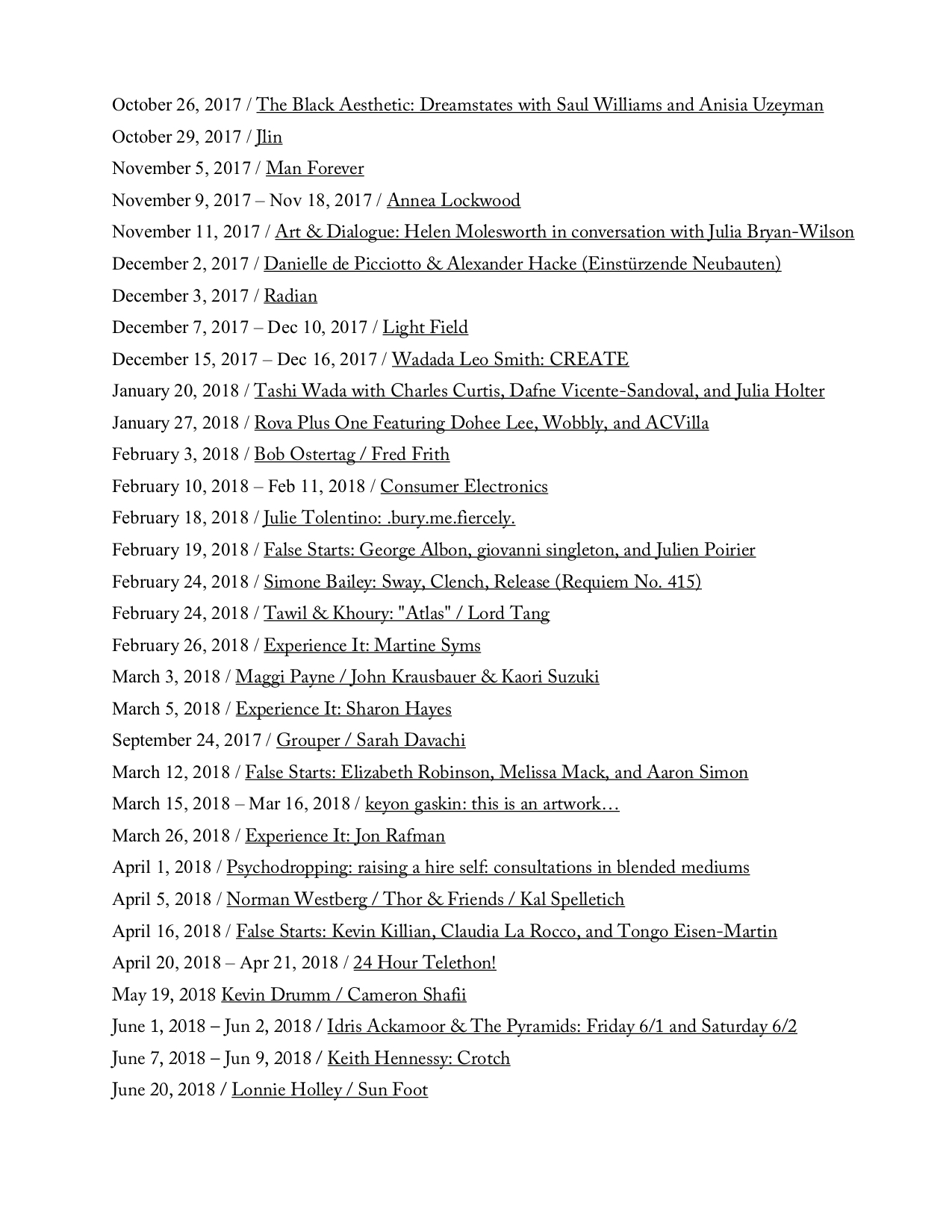
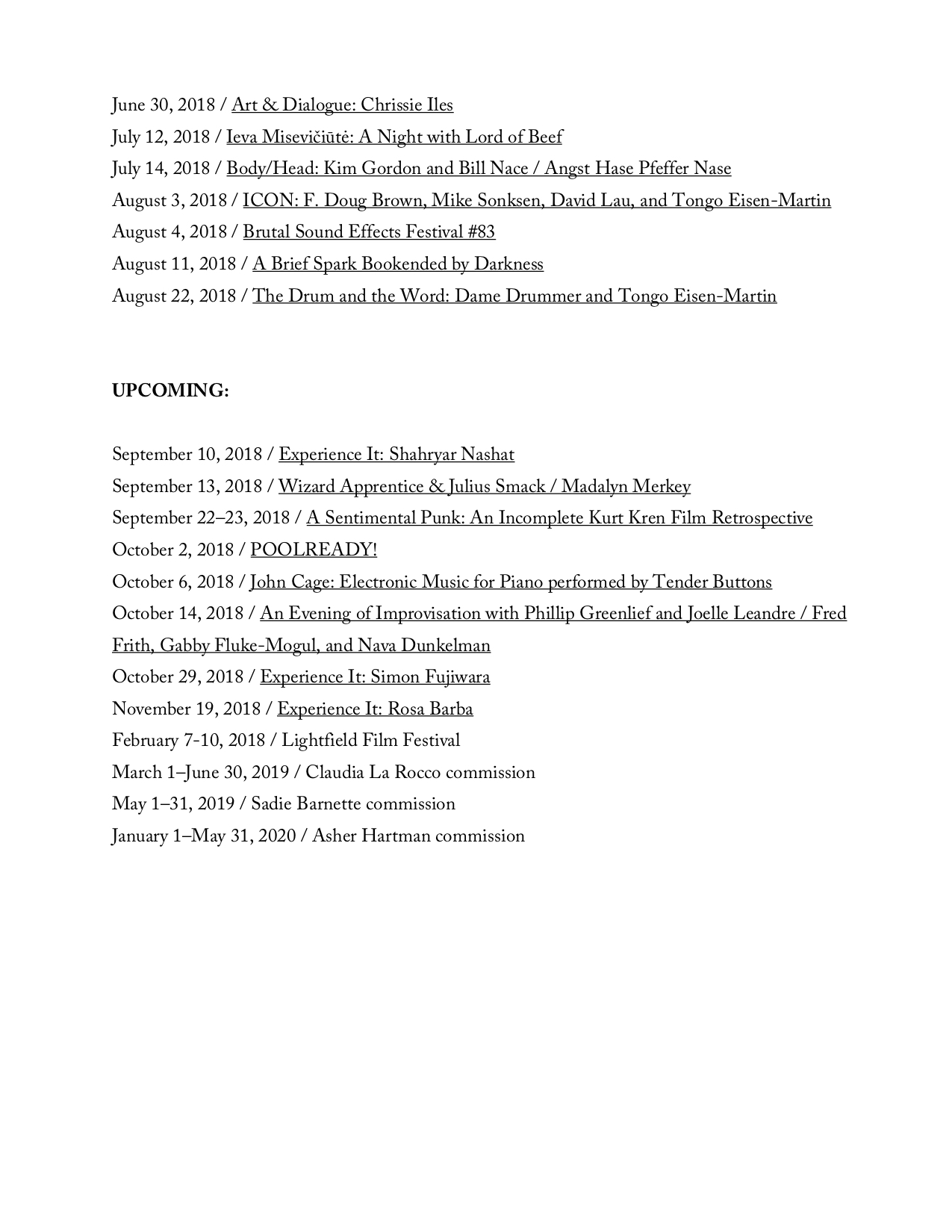
The Lab Reports 2017
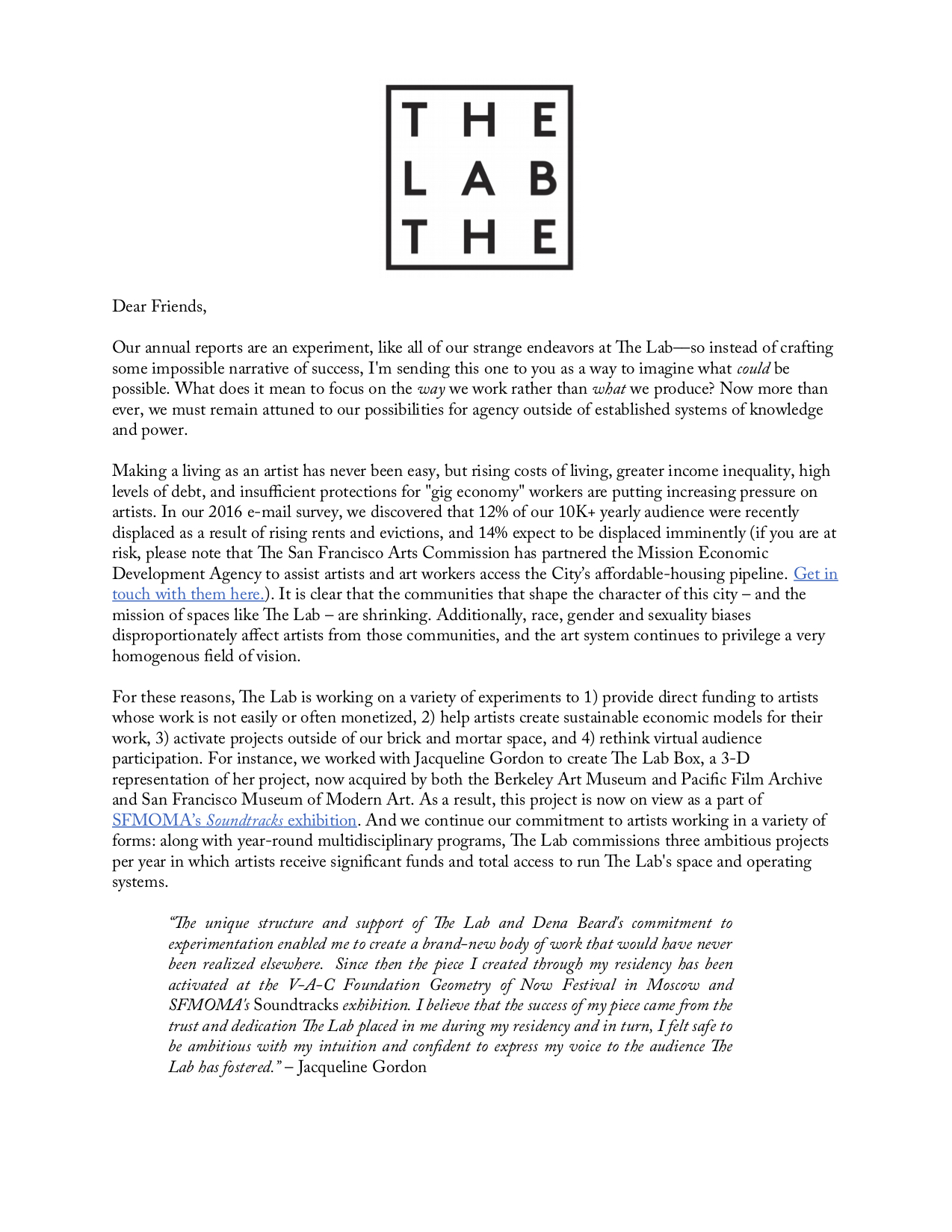
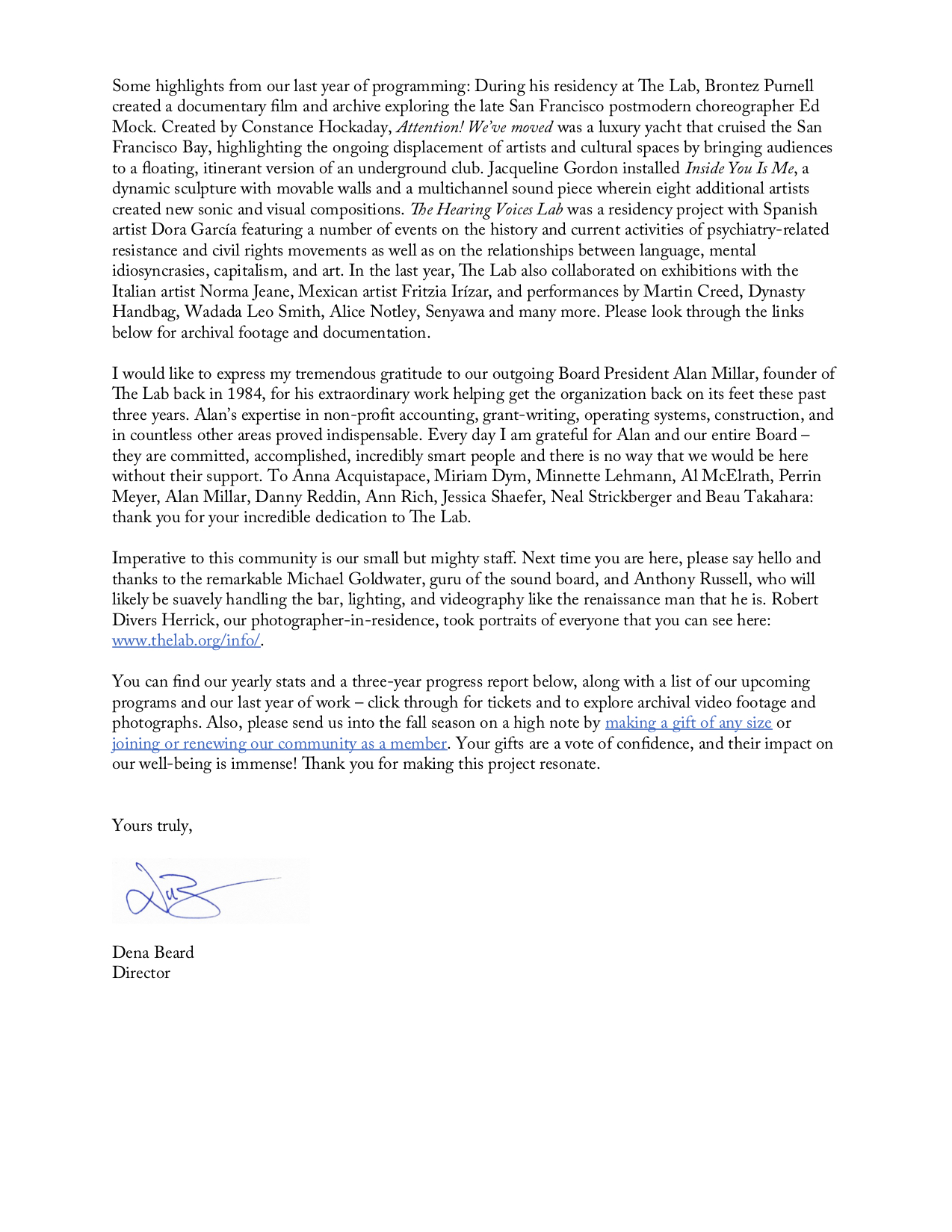
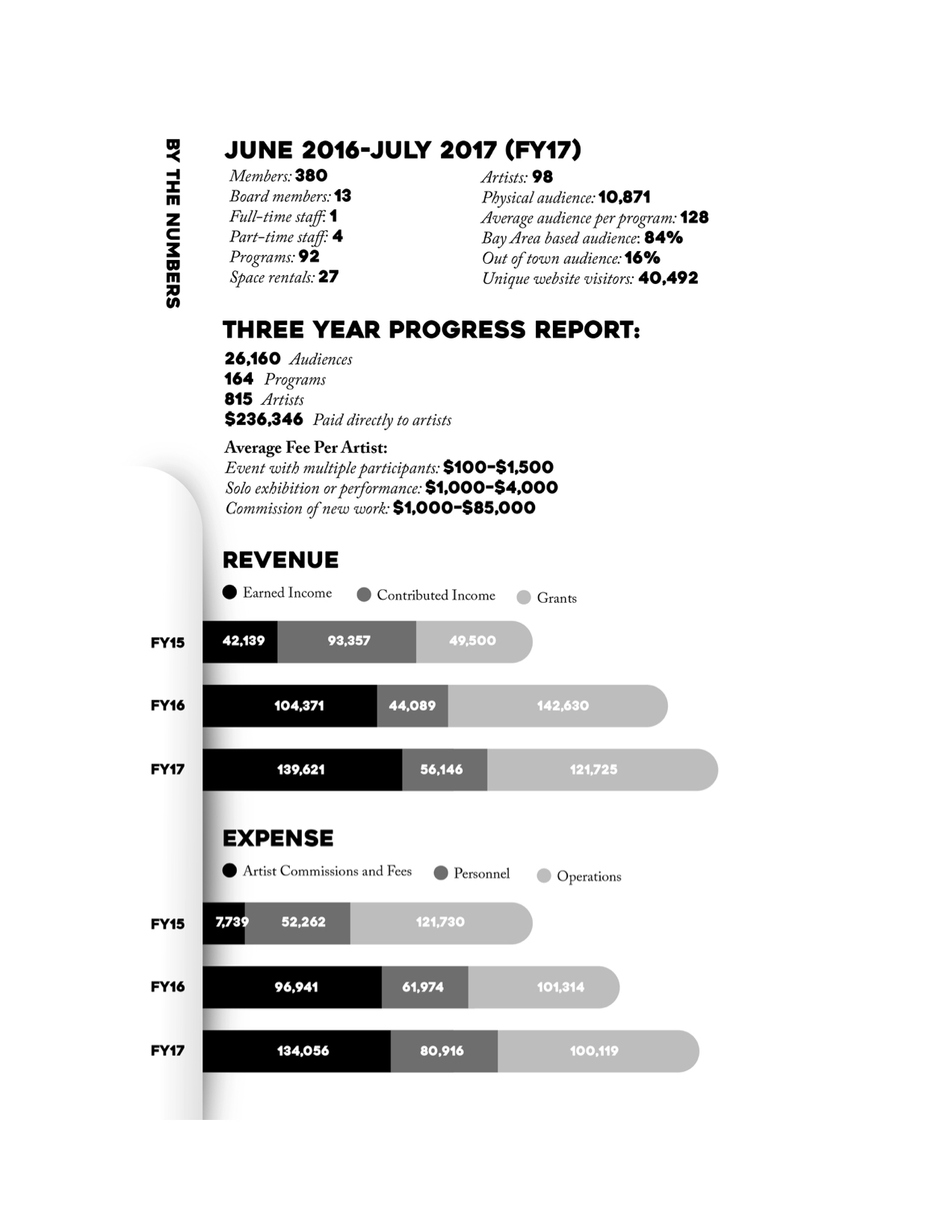
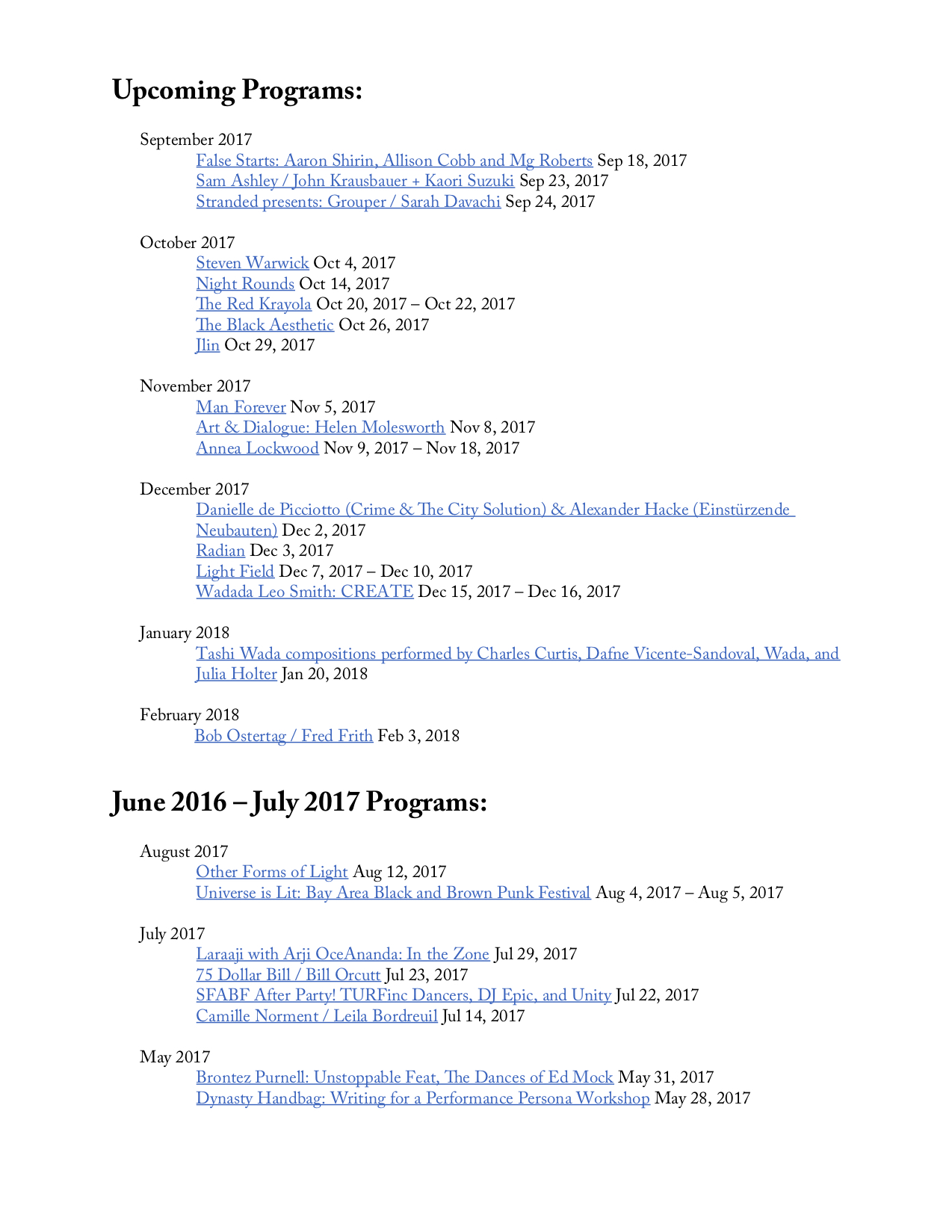
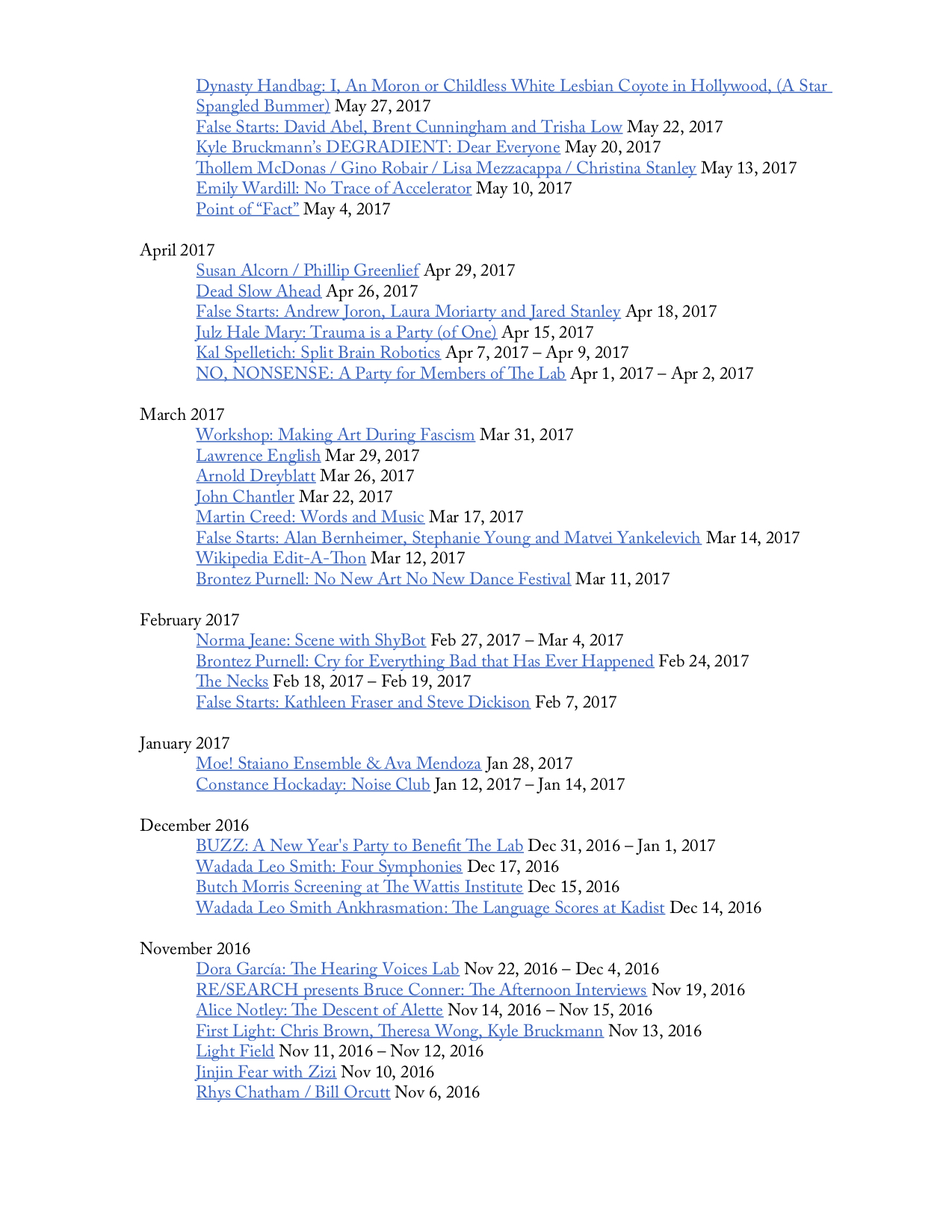
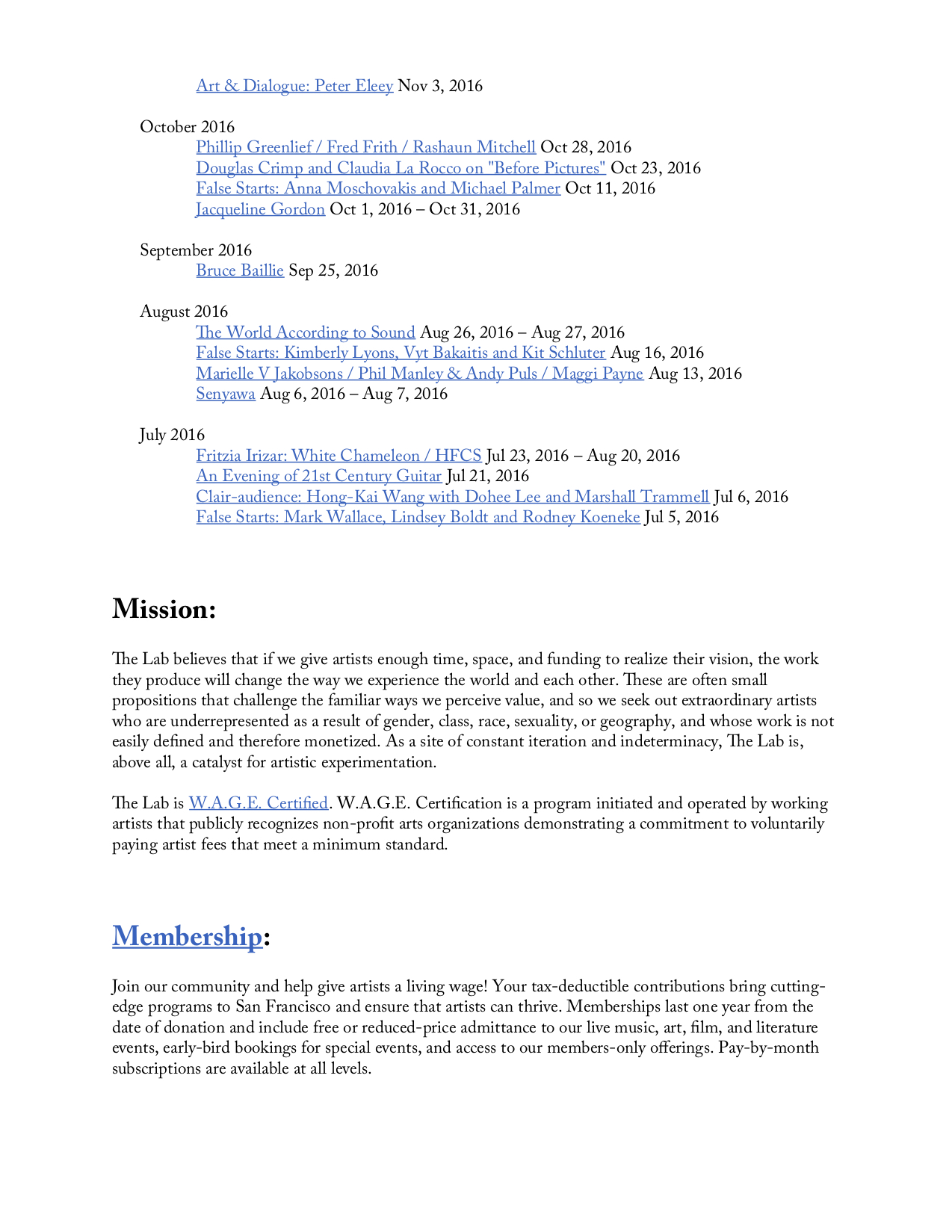
The Lab's Photographer-in-Residence: Robert Divers Herrick
The Zizi Show, "seeing how popular nonsense can be, how far bullshit can go."
Hello Zizi, I’m Jackie. I work at The Lab. We’re excited to have The Zizi Show and company here on Thursday, November 10. First question: you talk about fear and fear mongering, but fear is a pretty basic human instinct. So, how much is too much? On a related note, what do you think about the upcoming election?
Zizi: Oh Jackie, would you have a cigarette? Of course, The Lab. Is that the opera theater by the breathtaking urban lake of human condition? It is such an honor to perform at your establishment. I hope I have the time – I may have to tend to my hormonal headache on that evening. At any rate, you ask about fear Jackie. Oh, indeed, indeed. Too much, too little, who is to say? I will say. Fear is a basic instinct that allows us to survive, it is necessary to live – absolutamente. We all know that, mais, bien sur. I studied it in biology class when I was ten, or was it in political theory with sexy Almaz? At any rate most of us do not even encounter reasons for survival fear activation, with everything so boxed and in such formidable order. [Suffocation]. What is often referred to as fear nowadays are really phobias. A mix of dread and hate. Who is afraid of being caught in the line of fire of a tiger? Oooohhhh Jackie, did you see that video on whatever [media]that shows the two tourists being eaten up by a tiger in some zoo? Ha ha ha!!! Not funny. At all. Pas du tout! But really, when asked, the terror keeping folks awake all night boils down to irrational, fabricated, exaggerated fears. We have become too afraid to live, my dear. I say, beyond fear of boredom and, oh – do avoid crossing the streets while cars are present in some places – all other fear is too much.
Really, you have to be able to trace the reason for the fear, name it, and consider the real possibilities and their effect on your wellbeing.
I will give you an example of the irrationality that drives me mad: women live in fear almost always, everywhere, muscle tensing, character shaping, lifelong fear because they are women and are subject to a spectrum of violence by the other group – I forget its name. However, I do not see this fear considered seriously – even basically addressed – or resolved. But the suggestion that a certain group of people (often poorer, often darker) may present a danger, with no precedence or number to support the suggestion, and suddenly panic takes control. Walls. Armies. Bombs. Long, terribly boring security lines. Surveillance systems. REALLEEEE!?
The sheer terror of going on a three hour urban picnic without a snack, now that is legitimate.
To surrender one’s whole life to a job that is counter-natural, which causes stress and anxiety and a sense of “just another brick in the wall” to “secure” a pension – because there is nothing scarier than a senior life without a pension – this is the picture of horror. The work-stress will kill them before they cash that damn pension. I just read it is a bigger killer than smoking, Jackie, did you know that? Who cares where I read it. That is bloody too much. I am angry Jackie. This is too much. Heartbreaking.
I will give you another example Jackie, horror films. I never really watched them. How to Give Birth (the first one), that was the only horror film I ever watched. But I get it, there is something beautiful in indulging one’s instincts every once in a while. A moment in the wild, in the safety of a living room or a theater (of course there are living rooms and theaters that are more dangerous than US foreign policy), surrendering to the simple emotions, armed with choice, sitting to the physical and mental experience in front of horror, experiencing the parasympathetic system in action (gently) – I can see the fun. Holding one’s breath, gasping, screaming even are all allowed, holding the next person's limbs or/and easily located protrusions, silly words, being a fool, all part of the fun, eating popcorn way too much way too fast way too buttery (maybe even caramalised) all kosher. I get the pleasure in all of that. Sort of like when someone goes for the thrill of a dark room action, a BDSM circle, and /or a bungee jump situation. That can be cool. Especially the BDSM tickling fears, I am happy to answer any more Q&A in this regard Jackie, but better use my secret email.
But the paralysis that comes with imagining mayhem and chaos and anarchy and violence and fire and looting and the loss of shopping-opportunities if a refugee makes it to shore rather than die die die you asshole brown refugee freak – major problem.
ELECTIONS?? WHAT FUCKING ELECTIONS??
The Lab: Where did you develop your practice of “casting spells?”
Zizi: You ask me a question, seemingly so simple, short, quick and via the electronicalistic ways, yet really really, yes, what? No spell-caster shares her ways. But for you Jackie, for your purple lipstick, I shall share a couple of deepnesses supertarrallalaas. When I was really young, a really long yet very short time ago, and somewhere beyond imagination yet in everyone’s kitchen (for those who have kitchens, those who do not already know), I was given a gift. It was my birthday you see and she thought I could use a new pair of jeans. It was really sweet knowing breeze through short hair, fearless against the deeply rooted belief that if one takes a shower and one receives the wind in their face, within the same hour, their mouth will meet their eye, I could watch a sunrise hungry yet full.
Once upon a time, a family gathered around a child in a warm slightly moldy velvety living room with a large corner window by a Pinus sylvestris. The child knew her words but threw her syntax to the wind, she climbed the cushions of grandeur and gifted her wisdom to the poor, her heart breaking for the souls of lost awakenings, un-made-shy by a toe peeking through the woolen socks, diving head first into the thick laughter, the cigarette smoke and coffee textures, knowing there will never be no going back.
Time.
My sister. She brought me magic.
7 times the oracle’s epithet for finding misplaced items.
Tfeh tfeh tfeh [aimed at one’s own chest] to get rid of envy.
The Lab: Switching gears, you have several guests for your upcoming show. How did some of those relationships or connections evolve?
Zizi: Chemistry.
It is written in on the leaves of gold.
The perpetual dining table of the arts.
Sex.
Humor.
Friend - comrade - playmate.
Play.
Musakhkhan.
Pain.
All, some, and in no particular order.
The expanding web of
The Lab: Since the beginning of the talk show format in the 1940s the genre has taken on different forms across the globe. What are some of The Zizi Show’s main influences?
Zizi: Zizi you must understand is a multi time and space generator who just loves a cheese sandwich. Sometimes it is really complicated and obscene to look into influences, could the world have started with Zizi? It has been suggested. But, and this is between you and I, Zizi prefers anarchy in time and space and in how the species connect/interconnect. As Diane B., a role model for generosity, rebelliousness and the beauty in curiosity, once told me: “you just do not like being on the phone, that is who you are.” Kuteh Kuteh … Kuteh is one of my favorite mottos, it talks of liberation, loving the menstruating body and a timeless bond with an old friend, as well as a solid celebration of the silly.
I am touched and sobered by the voices of the mad on the streets, on public transport, in the corners, reminded that the mad can see. And, often times, most times, popularly, true madness is the norm. What is true and what is performance. What is sane and what is insane.
The cat (aka Rocca, The Rocks, Ruki and the Monster), sucking blood off my finger, shows me again (if only I would open my mind) that sleep, eat, stretch, play (mice may call it something else) are the essence of a good life.
The Little Prince, she was fearless.
Bodies standing for their sacred land against greed, oh them so fearless.
Bodies sustaining on hope against greedy industrial complexes profiting at the cost of their freedom. Oh them are fearless.
Seeing how popular nonsense can be, how far bullshit can go. To the sound of sexy radio voice – you know who you are – driving in a city no longer as quiet on any Friday to receive love in the form of a bursting stomach from a withdrawn matriarch, dreaming of a life behind a microphone.
Sabah Essabouha is a good influence: live, for fuck’s sake fucking live you fucking fool. For tomorrow may never be.
I also really like, what is her name, she is fat and funny and acted in that film with bollocks?
The Zizi Show is a project by The Rocca Family This talk show-performance-playground comes back with its latest edition entitled Jinjin Fear with Zizi this Thursday, November 10. Zizi will use her charms and cast her spells, surrender to Zizi and fearless you shall be. (probably, maybe).
A Year in the Life of The Lab
800K images in 3 1/2 minutes.
The Lab Reports 2016
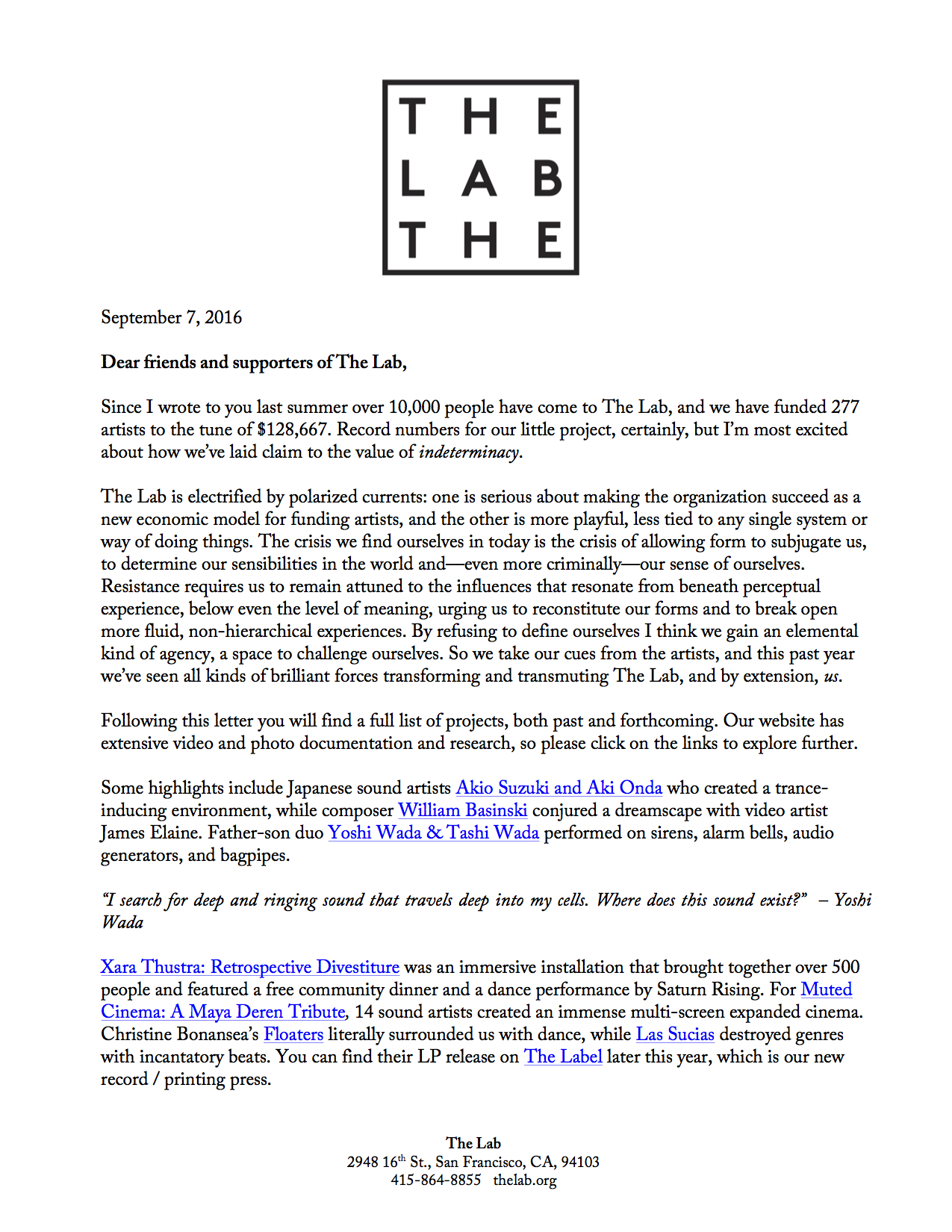

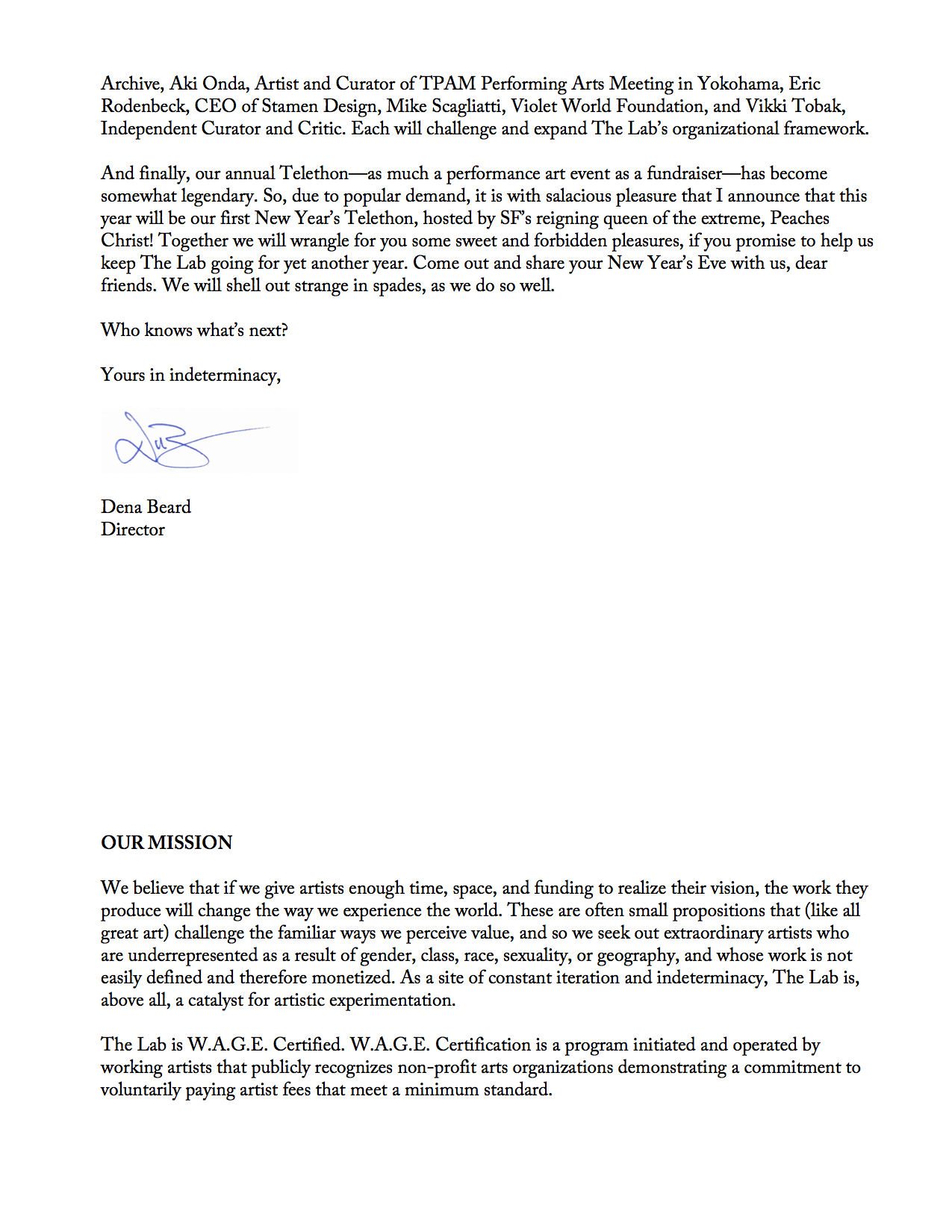
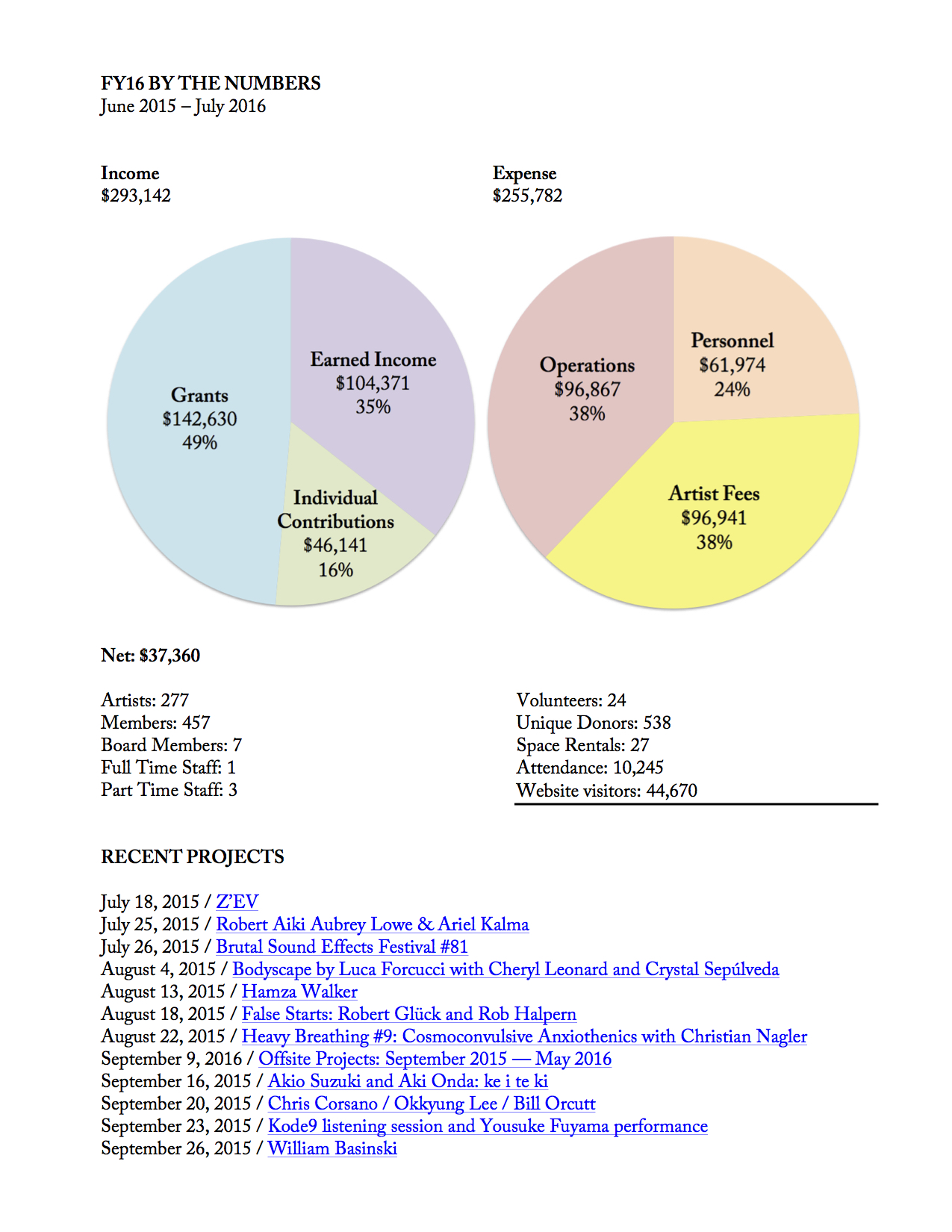

Bessma Khalaf interviewed by Esther Willa Stilwell
Over empanadas in The Mission, I sat down with Oakland based visual and performance artist Bessma Khalaf to talk about immigrating from Iraq, burning things, and Bay Area art. Khalaf exhibited at The Lab's 2008 show, “Détourned Menu: Food in the Form of Activism.” Bessma has also exhibited at Jack Shainman Gallery, New York, NY; Steven Wolf Gallery, San Francisco, CA; Southern Exposure, San Francisco, CA; Gallery Four, Baltimore, MD; 18th Street Arts Center, Santa Monica, CA and the ISE Cultural Foundation, New York, NY. She’s also been in publications such as Zyzzyva, Artforum, the San Francisco Tribune and Baltimore City Paper. – Esther Willa Stilwell, Summer 2016 intern at The Lab.
So, what have you been working on lately?
Lately I have been really fascinated with landscapes and burning. I always [start with] the concept, I have a weird idea triggered by a dream or a weird thought I have and I will write it down and then kind of meditate on it and think about the best way to illustrate that idea without diluting it, working from the conclusion. [I’ll] come at it at from different perspectives and mediums. Would it work better as a sculpture or performance? Sometimes they develop into multiple works.
Bessma Khalaf: Old Faithful, 2014; archival pigment print; 19 in x 18 in.; courtesy of the artist.
You tend to use mediums in unconventional ways. Can you tell me more about your relationship with those mediums?
My videos are not fancy, very still. This comes from a photography background – I think about it as a moving photo. My films tend to be silent because I want them to live with other things and not draw too much attention to them. So I like that idea and still play with it, but now I sometimes add nature soundtracks. [My photography] is really a process. I have been working a lot with collage, with old travel books. I rip out iconic places from them, just go to a crappy old bookstore, and take the very American places. I’ll burn them in ways that mimic the landscapes so it's like a controlled type of burn, obliterating these beautiful landscapes.
Bessma Khalaf: Meadow, 2014; archival pigment print, 23 in x 20 in.; courtesy of the artist.
What is your relationship to the landscapes you burn?
I’m originally from Iraq, and I moved here when the first Gulf War started. I was a 12 year old when I left. I have some images, but not landscapes. Babylon was an hour away, with beautiful ruins that were a thousand years old. I think these new pieces I have been working on are almost an act of terror on these beautiful places but they start to create these little landscapes where you can’t tell where the landscapes end and the burn begins. I love the abstraction. I don’t know, it's peaceful, new things come from it. Burning things is so cathartic.
I want to….. wait, there are some naked men! Hello, they are waving at us. Oh, it’s naked bike riding. Make sure you use baby powder on those butts. I don’t think it looks comfortable.
Haha! So anyway, what was it like moving from Iraq to California?
I migrated to the place that's actually destroying the place I came from. I’m seeking safety in this place where... I don’t know, like seeking shelter at your abuser’s house. I think that's really what fuels my art making. It comes from a conflicted place, but I will never go back. My family is Catholic, so there's just no way for us to go there safely. After landing at LAX I went to a [U.S.] supermarket for the first time and I was like, holy shit there is so much food. I had never seen anything like that before – Iraq is not like that. I still get weirded out by it. Just the abundance. Food and indulgence is fascinating to me. It really is the land of plenty, but it's so over the top.
Does that indulgence and abundance influence your work?
I’v always been attracted to convulsive beauty. I love gross things being beautiful. So [in grad school] I made the eating video. I made the food sculpture. it was really fun. At first it was just a sculpture and then I was like--I could eat it. Then I made another one, but bigger and I took a video of me eating it. There is lots of self punishing and pushing my comfort. I want to see if I can do it. It's part of a challenge like if I can do this, I can do that. I just did a piece at Southern Exposure where I stared at a painting for 8 hours for the 8 hour work day they had. I kept on tasering it every hour. At the time there was a lot of protest in Oakland about police and guns and tasers.
What is it like being an artist in the Bay Area?
I have lived in the Bay Area for 11 years. Its really hard here, it's conservative if you’re not making the right kind of work or schmoozing with the right people. It’s small. Here there is a theme with work because people know it's popular. So I took a break from making actual work. I was having these ideas, but where am I going to show it? Will it just sit in my studio? There is so much money up here, but no one wants to give it to the arts.
Bessma’s studio and popup shop in downtown Oakland.
Can you tell me about the show you did at The Lab?
The show at The Lab was all based on food, so I used chocolate. I had this weird idea of regurgitating oil because I’m from Iraq. It was kind of a joke because I was like an Iraqi oil fountain: all this black matter coming out of my mouth from above the screen that just never ends. There was a lot of cool stuff. I’m pretty sure I got drunk, but it was fun. It’s a cool space.
Okay, one last question. When did you decide you wanted to be an artist? Why do you make art?
I didn’t get into art until my third year of junior college. I realized I enjoyed it so much and I was good at it. It was getting something out of me. Not spiritual, but it made me feel good. Making things with your hands, maybe because I’m a Taurus.
Example of Kokedama fern (also referred to as "poor man's bonsai”).
Me too!
So we like making beautiful objects, functional and tactical things. When I see a beautiful chair I’m like who who did this? I touch it and i’m like, Ooooh. The thing is with my work I tend to make it beautiful somehow to hook people. It’s like my cheap trick. If you can capture their attention then they will stay. That's very American, learned from commercials. Nature is so beautiful and it is not ignored.
Oh! Lately, as I’m getting older, I am getting into more meditative shit. So I started doing these accent bonsai plants. You take them and strip the dirt from the roots... and encase the roots around this clay. You take that and wrap the clay in moss and then wrap string around it and they survive like that. I love them. I’m kind of obsessed with them. So Taurus, beautiful objects. I even have some in my shower.
Bessma and her partner make silk screen scarves: lightdarkstudio.com.
Bill Berkson, 1939–2016
Remembering our friend, the reverberant Bill Berkson. With tremendous love to Connie.
First up on The Label: Jacqueline Kiyomi Gordon and Zackery Belanger's Acoustic Deconstruction
On January 28, 2015 Jacqueline Kiyomi Gordon and Zackery Belanger collected sounds from the then recently closed UC Berkeley Art Museum and Pacific Film Archive at 2626 Bancroft Way. Described by many as a Brutalist masterpiece, the space was shuttered only a few days before. Its future continues to be uncertain but Gordon and Belanger captured a representation of the buildings acoustic soul. In Gordon's words "a document to better understand the performances that were [at the BAMPFA] over the past 40 years." Those sounds and the resulting interpretations from artists Ingrid Lee, Matt Ingalls, and Maggie Payne are Acoustic Destruction.
"In a lot of ways this is about engaging and educating the public. Allowing them to hear the sounds of the 2626 Bancroft Way. Even though we cannot fully reproduce those sounds, we can retain some sort of memory of it and present these remembrances to artists and audiences" - Zackery Belanger
Acoustic Destruction is the first publication on The Lab's new label aptly labeled The Label (alliteration, folks). The LP is also one of many rewards available as part of our currently active Kickstarter campaign, Keep It Experimental feat. Kembra Pfahler. This campaign is part of an ongoing effort to empower artists to realize ambitious ideas and to invite the public in on that process. Join in and Keep it Experimental.
4 (less obvious) Influences on Las Sucias
Las Sucias is a feminist noise duo formed by Danishta Rivero and Alexandra Buschma. The Oakland based group's chaotic mix of influences range from old school Caribbean styles such as Reggaetón, Dembow and Dancehall, to Noise, European 1960's vanguard, Goth, Riotgrrrl Punk, Free Jazz, Experimental and Industrial. Additionally their sound was shaped by BOMBA and GAITA DE TAMBORA DE VENEZUELA, styles that already contain a blend of the cultures of Venezuela and Puerto Rico respectively.
Amongst their biggest influences are Latina queens: LA LUPE, IVY QUEEN, CHAVELA VARGAS, RITA INDIANA and CELIA CRUZ, and non-Latina queens DIAMANDA GALAS, LAURIE ANDERSON, PATTY WATERS, and ELIZABETH FRASER.
Still they have other big aural guides that are perhaps less obvious. Las Sucias gave The Lab a little homework as preparation for their live recording for a new LP this Saturday April 23.
Can't make the performance? Las Sucias' vinyl record is one of many rewards included in The Lab's Kickstarter Keep It Experimental. Watch and learn, you will be quizzed this Saturday.
ONE.
TWO.
THREE.
FOUR.
"To wake the nations underground," M. Lamar on new work DESTRUCTION
M. Lamar is a composer who works across opera, metal, performance, noise, video, sculpture and installation to craft sprawling narratives of radical racial and sexual becomings. We asked them a few questions in preparation for their and Hunter Hunt-Hendrix performance this Thursday, April 14.
The Lab: M. Lamar, we're excited to have you at The Lab this week. Tell us a bit about the show and your collaborator.
M. Lamar: I’m super excited to have a show at The Lab. I’m also super excited about Hunter Hunt-Hendrix my co-composer and sound designer. He’s performing live with me; he’s a brilliant musician and philosopher. He’s really famous for being the author of Transcendental Black Metal and has this whole thing about the Transcendental Black Metal, as an American thing, as opposed to Europen Black Metal. He has a very sophisticated way of thinking about what he is doing in music which I would like to think we have in common
He’s a metal musician that is classically trained and also into western philosophy which I think is really exciting. It was clear that we are like-minded. He has a solo project Kel Valhaal that people should check out as well as Liturgy, an amazing band.
The Lab: For those folks that caught your performance Surveillance at San Francisco Arts Institute (SFAI), how does DESTRUCTION differ from that experience?
M. Lamar: Well DESTRUCTION is a new piece and a very specific story. What’s different about DESTRUCTION is that it takes place 100 years from now, and and represents a shift in my work from a focus on the past –to better understand our current moment to a focus on the future where when we can finally destroy white supremacy.
About two years ago, I started performing what I called Doom Spirituals. I was exploring spirituals, specifically My Lord In The Morning. I’d been listening to it since I was a little kid; I hadn’t realized there’s all this stuff about the end of the world, the dead coming back to life, and Jesus coming back. It was really interesting that slaves would be writing these words longing for an end of the world. They’re predicting the end of this particular world that was oppressing them. I liked that idea, and I liked the idea of setting it 100 years from now and that the music for this spiritual would have a very destructive and doom like setting.
Surveillance was a historical piece that happened in 1947, then it goes back to 1847, then back to 1947 and is meant to reflect back on today. Spirituals were not so much a focus of Surveillance. I think that is really distinctly different.
DESTRUCTION is my response to all these deaths we’ve witness from Trayvon Martin to Kalief Browder, to Mike Brown and Sandra Bland. It’s really a protest piece about police violence. Narratively we start at a funeral and this place of mourning, a loss of the most beloved. Though the century–from now to 2116– there is this carrying of the coffin of the most beloved. Ultimately we are waiting for them to return. All these themes, mourning, remembrance, resurrection, and return are really different from Surveillance. It’s a really romantic piece and in a way a more hopeful piece.
The Lab: Would you dare say optimistic?
M. Lamar: Ah, well I don’t like that word but I like the idea of hope. I like the idea that we can, in a very romantic way, carry the fallen on our backs. There’s imagery in the show of a coffin carrying, its like saying “We will never, ever, ever, ever forget you.” We’re devastated by it in such an unjust way but your death is it’s not in vain. I was so moved when Tamir Rice’s mother; when it was decided that the police would not be indicted, It’s just the most illogical thing I can think of. It’s angering and upsetting. I remember seeing her on the now defunct Melissa Harris Perry show saying that she needed the death of her child to mean something. That she would forever fight for justice for victims of gun violence and justice in terms of his particular death so no other child could die in this way. Really DESTRUCTION is about all that. Another example is Emmett Till’s mother, Mamie Till-Mobley. She decided to have an open casket and said effectively “I will fight for justice for the rest of my life.” It’s that kind of moment, you know; it’s horrifying but also hopeful. I want to give a voice to the dead, so that there is a resurrection and a rising. They need to have a moment.
Emmett Till’s mother, Mamie Till-Mobley
The Lab: What sounds are shaping DESTRUCTION and what are some of your musical influences that go under recognized?
M. Lamar: Free jazz composer Cecil Taylor is great. I was in a class, where they screened a lecture of him speaking and it completely changed me. Right now Cecil Taylor is really on my mind because the Whitney Museum of American Art is doing a series of events with him! Leontyne Price, Jessye Norman, Marian Anderson, Paul Robeson–all those black opera singers were a huge, huge deal to me.
I love a lot of funeral doom bands like Winter or Envoken, or Skepticism. I think my metal influences don’t get as much attention. One of the things Hunter and I have been talking a lot about, we’re really interested in opera and we’re really interested in metal. We want to blend a kind of black metal sensibility musically with an operatic sensibility. Or like Dartkthrone or Sunn o))) in terms of bands that I love.
I also love like campy stuff like Marilyn Manson. I completely love.
The Lab: OOOooooo
M. Lamar: I think his influence on me more in terms of style, like walking around bringing irreverent goth into the everyday. That’s probably surprising or maybe not surprising.
The Lab: Did you go to The Lab when you were here as a student at SFAI?
M. Lamar: I did. I remember seeing a lot of great things at The Lab. It’s always been a San Francisco institution. So yes absolutely.
The Lab: What your perspective on San Francisco, creative spaces?
M. Lamar: I left San Francisco almost 10-years ago. It’s a different place now than it was when I was going to school because of the tech thing that happened. The tech boom, Google, Twitter, Uber. It’s become a lot less of a place for weirdos and freaks to thrive. I think that was what San Francisco had historically been about and those people have been priced out of San Francisco. Strangely I think a lot of people have moved to Los Angeles. Of San Francisco, William S. Burroughs said (now they say it about Portland), “San Francisco is the city where the young go to retire.” It has famously been a city, not of ambition. Unfortunately San Francisco kind of depresses me now. The culture has completely changed. All the culture that I knew is almost completely gone. I think that’s why it’s great that The Lab is still standing. I think Dena is doing a great job. I’ve heard amazing things about what Dena is doing, in terms of programming, Charlemagne Palestine was there doing a show recently as well Robert Aiki Aubrey Lowe aka Lichens. I'm excited The Lab still exists and that I am playing there!!!!
M. Lamar and Hunter Hunt-Hendrix perform DESTRUCTION, this Thursday April 14. Not in San Francisco, M. Lamar: Funeral Doom Spiritual opens at ONE Archive in Los Angeles, April 15 to July 30, 2016.
Changes were made to this interview on April 12, 2016 to more accurately represent the artist. The title of the blog is based on lyrics and concepts associated with the spiritual My Lord, What A Morning.
A Ticking Clock: Five Questions for Ellen Fullman
Fullman at Headlands Center for the Arts, photo credit: Judy Dater
"All good performers seem to feel they are a transmitter; music doesn't come from you, it moves through you." Ellen Fullman interviewed by The Lab's Jackie Clay
Read More